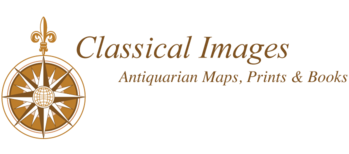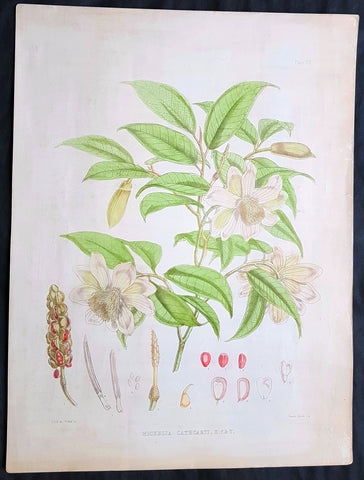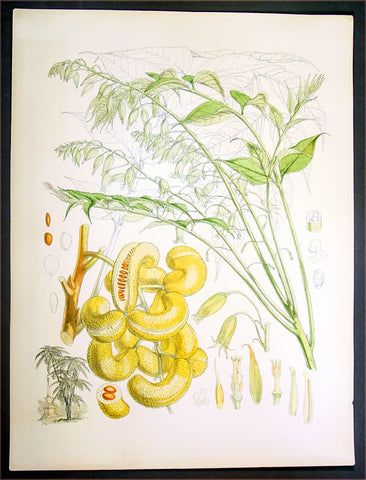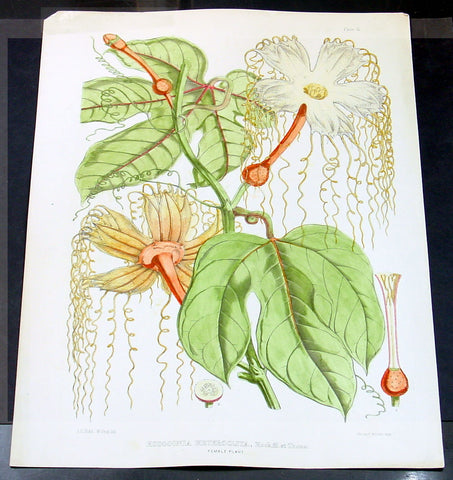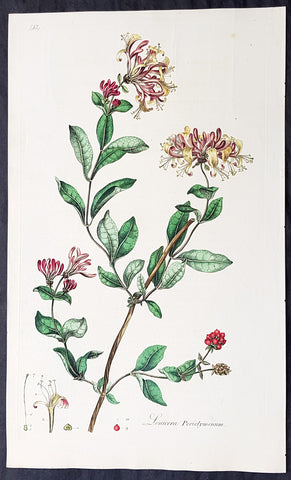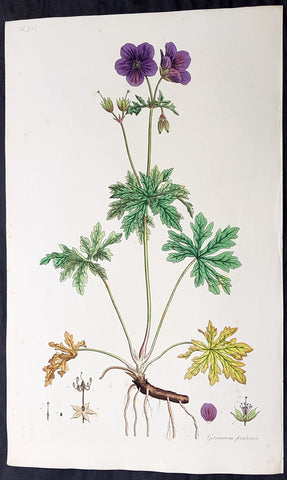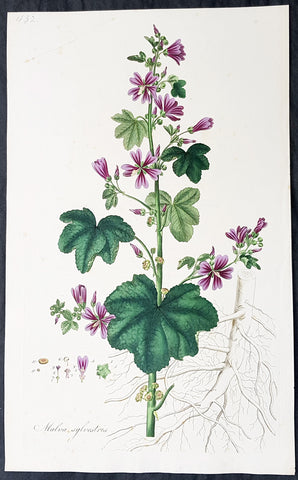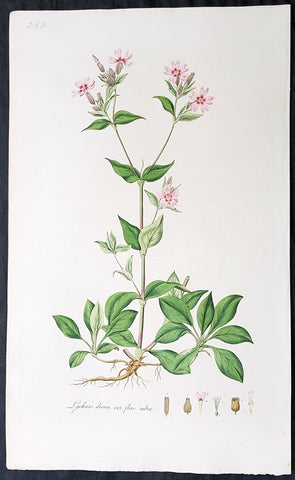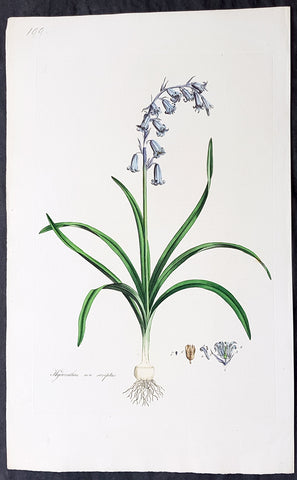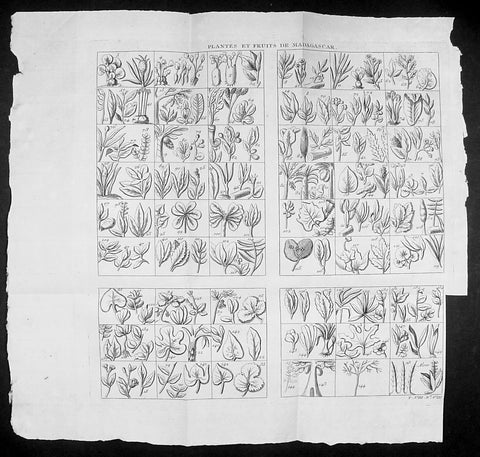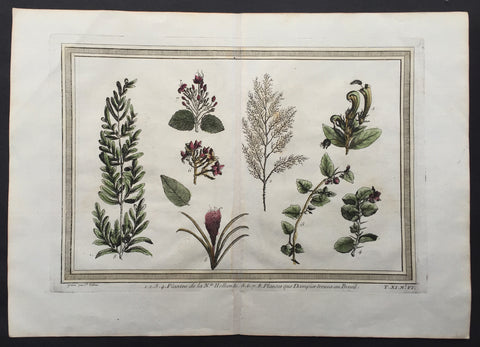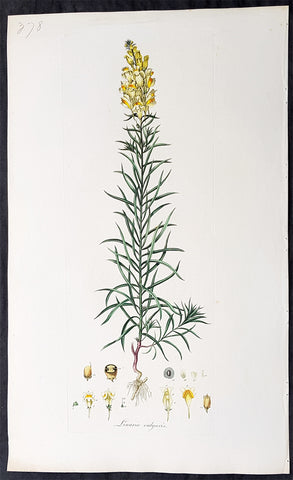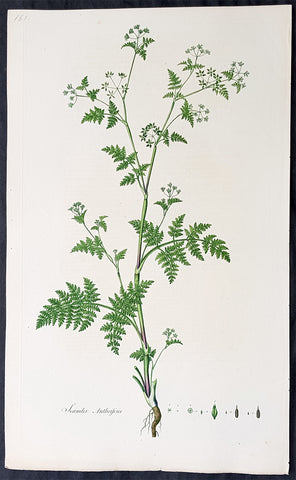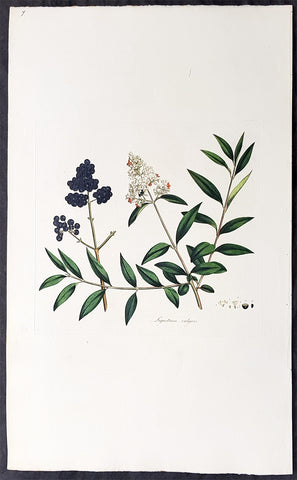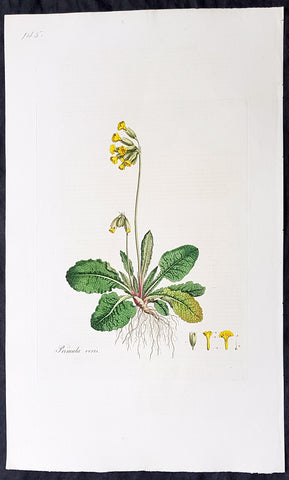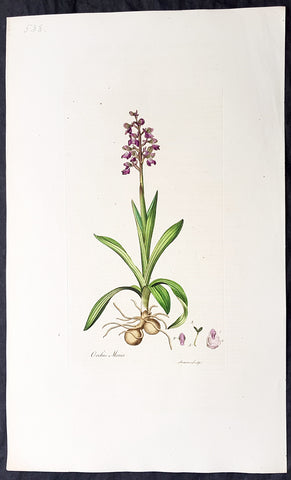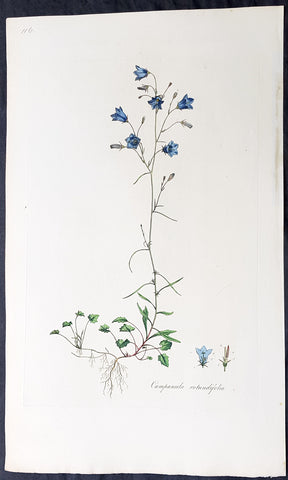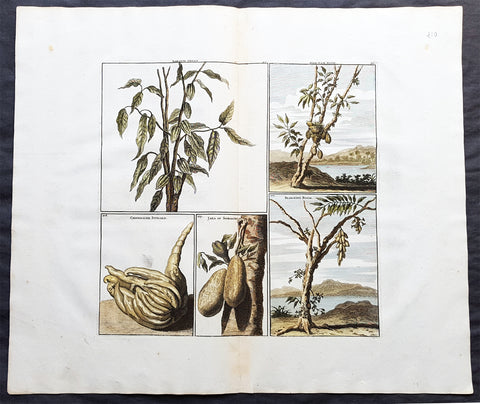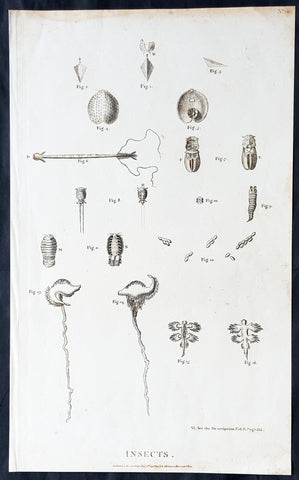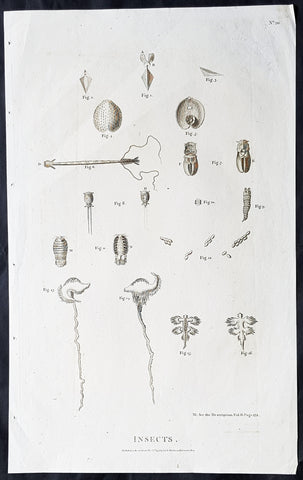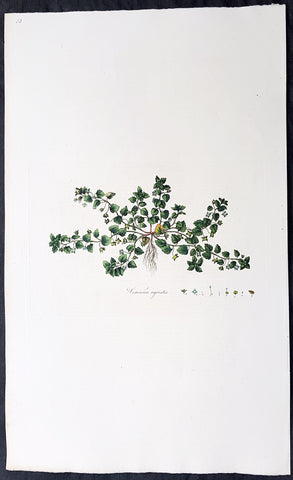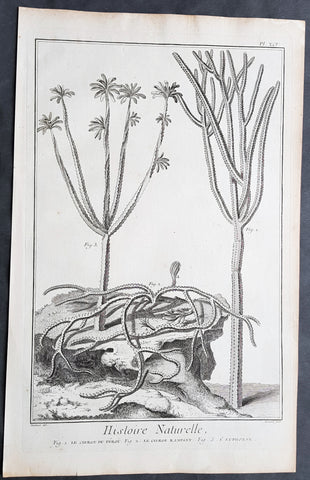Botanical (21)
1855 Hooker & Fitch Original Antique Botanical Print of Fairy Magnolia Tree
- Title : Michella Cathcarti, H.f.T.
- Ref : 80771
- Size: 20in x 15in (510mm x 380mm)
- Date : 1855
- Condition: (A) Very Good Condition
Description:
This beautifully hand coloured original 1855 antique lithograph print of the Michella cathcartii or Fairy Magnolia, originally found at the foot hills of the Himalayas, is one of a series of illustrations made for J. F. Cathcart of the Bengal Civil Service by Sir Joseph Dalton Hooker for the 1855 publication of Illustrations of Himalayan plants.
This publication contained 24 coloured plates all superbly engraved and hand coloured. The plates were executed by W. H. Fitch, analysed by the famous botanist J. D. Hooker.
General Definitions:
Paper thickness and quality: - Heavy and stable
Paper color : - off white
Age of map color: - Original
Colors used: - Yellow, green, blue, pink
General color appearance: - Authentic
Paper size: - 20in x 15in (510mm x 380mm)
Plate size: - 20in x 15in (510mm x 380mm)
Margins: - Min 1in (25mm)
Imperfections:
Margins: - Light soiling to margins
Plate area: - Light soiling
Verso: - Light soiling
Background:
Michella cathcartii...The following is an excerpt from Hooker's description..... "This is a very common tree on the outer range of the Sikkim-Himalaya. It is conspicuous in April from the abundance of blossoms with which in some years the branches are covered, appearing as if snowed upon. It has hitherto been found nowhere but in Sikkim, and bears the name of Mr. Cathcart, around whose residence at Leebong, near Dorjiling, some fine trees of it stood. The wood is good, and used by the Bengali carpenters, who give it the name of Champa"
1855 Hooker Fitch Antique Botanical Print China Mao Er Shi Goat Horn
- Title : Decaisnea Insignis H. F & T
- Date : 1855
- Condition: (A+) Fine Condition
- Ref: 80767
- Size: 20in x 15in (510mm x 380mm)
Description:
This beautifully hand coloured original 1855 antique lithograph print of the Decaisnea insignis or by its Chinese name Mao Er Shi (Transcribed Chinese) cat faeces or goat horns, that grows in China & SE Asia, is one of a series of illustrations made for J. F. Cathcart of the Bengal Civil Service by Sir Joseph Dalton Hooker for the 1855 publication of Illustrations of Himalayan plants.
This publication contained 24 coloured plates all superbly engraved and hand coloured. The plates were executed by W. H. Fitch, analysed by the famous botanist J. D. Hooker.
Decaisnea insignis Mao Er Shi (Transcribed Chinese - Cat faeces or Goat Horns - is a genus of flowering plant in the family Lardizabalaceae, native to eastern Asia, from China west to Nepal and south to Myanmar.
The genus comprises one or two species, depending on taxonomic opinion. Decaisnea insignis (Griffith) Hook.f. & Thomson was described from Nepal, and is sometimes restricted to the plants occurring in the Himalaya, with Chinese plants distinguished asDecaisnea fargesii Franchet. The only cited distinction (e.g. Bean 1973, Rushforth 1999) between the plants from the two regions is the fruit colour, yellow-green in D. insignis and bluish in D. fargesii. This is of little significance and the two are now combined under the older name D. insignis by some authors (e.g. Flora of China).
Sir Joseph Dalton Hooker (1817 – 1911) was one of the greatest British botanists and explorers of the 19th century. Hooker was one of the founders of geographical botany, and Charles Darwin's closest friend. He was Director of the Royal Botanical Gardens, Kew, for twenty years, in succession to his father, William Jackson Hooker, and was awarded the highest honours of British science.
On 11 November 1847 Hooker left England for his three year long Himalayan expedition; he would be the first European to collect plants in the Himalaya.
By his travels and his publications, Hooker built up a high scientific reputation at home. In 1855 he was appointed Assistant-Director of the Royal Botanic Gardens, Kew, and in 1865 he succeeded his father as full Director, holding the post for twenty years. Under the directorship of father and son Hooker, the Royal Botanical gardens of Kew rose to world renown. At the age of thirty, Hooker was elected a fellow of the Royal Society, and in 1873 he was chosen its President (till 1877). He received three of its medals: the Royal Medal in 1854, the Copley in 1887 and the Darwin Medal in 1892. He continued to intersperse work at Kew with foreign exploration and collecting. His journeys to Palestine, Morocco and the United States all produced valuable information and specimens for Kew.
He started the series Flora Indica in 1855, together with Thomas Thompson. Their botanical observations and the publication of the Rhododendrons of Sikkim-Himalaya (1849–51), formed the basis of elaborate works on the rhododendrons of the Sikkim Himalaya and on the flora of India. His works were illustrated with lithographs by Walter Hood Fitch.
Walter Hood Fitch (1817 - 1892) was a botanist and botanical artist. He was born in Glasgow, Scotland.
Fitch was involved in fabric printing from the age of 17 and took to botanical art after being discovered by William Jackson Hooker, the editor of Curtis's Botanical Magazine. Hooker was a Professor of Botany at the University of Glasgow, and a competent botanical artist in his own right.
Fitch's important works are his illustrations for W. J. Hooker's A Century of Orchidaceous Plants (1851), and for James Bateman's A Monograph of Odontoglossum (1864-74). He also created around 500 plates for Hooker's Icones Plantarum (1836-76). Some of his most notable work was for George Bentham and W.J. Hooker's Handbook of the British Flora (1865). When Joseph Dalton Hooker returned from his travels in India, Fitch prepared lithographs from Hooker's sketches for his Rhododendrons of Sikkim Himalaya (1849-51) and, from the drawings of Indian artists, for his Illustrations of Himalayan Plants (1855).
A dispute over pay with Joseph Dalton Hooker ended Fitch's service to both the Botanical Magazine and Kew although he was much sought after and remained active as a botanical artist until 1888. Works during this period included Henry John Elwes's Monograph of the Genus Lilium (1877-80). (Ref: M&B; Tooley)
General Description:
Paper thickness and quality: - Heavy & stable
Paper color: - White
Age of map color: - Early
Colors used: - Red, pink, green, brown
General color appearance: - Authentic
Paper size: - 20in x 15in (510mm x 380mm)
Margins: - Min 1/2in (12mm)
Imperfections:
Margins: - Light soiling top left & bottom of margin
Plate area: - None
Verso: - None
1855 Joseph Hooker & Water Fitch Large Antique Botanical Print of Lard Fruit of SE Asia - Hodgsonia
- Title: Hodgsonia Heteroclita, Hook. fil. et Thoms
- Date: 1855
- Ref: 80768
- Size: 20in x 15in (510mm x 380mm)
- Condition: A+ Fine
Description:
This beautifully hand coloured original 1855 antique lithograph print of the Hodgsonia or Lard Fruit plant - that grows from northern India to SE Asia & Indonesia, is one of a series of illustrations made for J. F. Cathcart of the Bengal Civil Service by Sir Joseph Dalton Hooker for the 1855 publication of Illustrations of Himalayan plants.
This publication contained 24 coloured plates all superbly engraved and hand coloured. The plates were executed by W. H. Fitch, analysed by the famous botanist J. D. Hooker.
General Description:
Paper thickness and quality: - Heavy & stable
Paper color: - White
Age of map color: - Early
Colors used: - Red, pink, green, brown
General color appearance: - Authentic
Paper size: - 20in x 15in (510mm x 380mm)
Margins: - Min 1/2in (12mm)
Imperfections:
Margins: - Discolouration to the top left & right margins
Plate area: - None
Verso: - None
Hodgsonia or Lard Fruit - Although the flesh of Hodgsonia fruit is inedible and considered worthless, the large, oil-rich seeds are an important source of food. The kernels are occasionally eaten raw; they are slightly bitter, possibly due to an unidentified alkaloid or glucoside, but "perfectly safe" to eat. More commonly, the seeds are roasted, after which they taste like pork scraps or lard; many mountain peoples consider these roasted seeds a delicacy. In addition to eating the seeds alone, the Naga incorporate them into various types of curry.
Sir Joseph Dalton Hooker (1817 – 1911) was one of the greatest British botanists and explorers of the 19th century. Hooker was one of the founders of geographical botany, and Charles Darwin's closest friend. He was Director of the Royal Botanical Gardens, Kew, for twenty years, in succession to his father, William Jackson Hooker, and was awarded the highest honours of British science.
On 11 November 1847 Hooker left England for his three year long Himalayan expedition; he would be the first European to collect plants in the Himalaya.
By his travels and his publications, Hooker built up a high scientific reputation at home. In 1855 he was appointed Assistant-Director of the Royal Botanic Gardens, Kew, and in 1865 he succeeded his father as full Director, holding the post for twenty years. Under the directorship of father and son Hooker, the Royal Botanical gardens of Kew rose to world renown. At the age of thirty, Hooker was elected a fellow of the Royal Society, and in 1873 he was chosen its President (till 1877). He received three of its medals: the Royal Medal in 1854, the Copley in 1887 and the Darwin Medal in 1892. He continued to intersperse work at Kew with foreign exploration and collecting. His journeys to Palestine, Morocco and the United States all produced valuable information and specimens for Kew.
He started the series Flora Indica in 1855, together with Thomas Thompson. Their botanical observations and the publication of the Rhododendrons of Sikkim-Himalaya (1849–51), formed the basis of elaborate works on the rhododendrons of the Sikkim Himalaya and on the flora of India. His works were illustrated with lithographs by Walter Hood Fitch.
Walter Hood Fitch (1817 - 1892) was a botanist and botanical artist. He was born in Glasgow, Scotland.
Fitch was involved in fabric printing from the age of 17 and took to botanical art after being discovered by William Jackson Hooker, the editor of Curtis's Botanical Magazine. Hooker was a Professor of Botany at the University of Glasgow, and a competent botanical artist in his own right.
Fitch's important works are his illustrations for W. J. Hooker's A Century of Orchidaceous Plants (1851), and for James Bateman's A Monograph of Odontoglossum (1864-74). He also created around 500 plates for Hooker's Icones Plantarum (1836-76). Some of his most notable work was for George Bentham and W.J. Hooker's Handbook of the British Flora (1865). When Joseph Dalton Hooker returned from his travels in India, Fitch prepared lithographs from Hooker's sketches for his Rhododendrons of Sikkim Himalaya (1849-51) and, from the drawings of Indian artists, for his Illustrations of Himalayan Plants (1855).
A dispute over pay with Joseph Dalton Hooker ended Fitch's service to both the Botanical Magazine and Kew although he was much sought after and remained active as a botanical artist until 1888. Works during this period included Henry John Elwes's Monograph of the Genus Lilium (1877-80). (Ref: M&B; Tooley)
1777 W. Curtis Large Antique Botanical Print Lonicera Periclymenum - Honeysuckle
- Title : Lonicera Periclymenum. Honeysuckle or Woodbine
- Ref #: 93471
- Size: 19in x 11 1/2in (490mm x 295mm)
- Date : 1777 - 1798
- Condition: (A+) Fine Condition
Description:
This beautifully hand coloured original copper-plate engraved antique botanical print by William Curtis was published in his large 1st edition folio edition of his famous and most enduring 6 volumes of Flora Londinensis: or, plates and descriptions of such plants as grow wild in the environs of London: with their places of growth, and times of flowering, their several names according to Linnæus and other authors: with a particular description of each plant in Latin and English. To which are added, their several uses in medicine, agriculture, rural economy and other arts. published between 1777 & 1798.
Also accompanying the print is the original text page, giving an in-depth description of the plant and its attributes.
General Definitions:
Paper thickness and quality: - Heavy and stable
Paper color : - off white
Age of map color: - Original
Colors used: - Yellow, green, blue, pink
General color appearance: - Authentic
Paper size: - 19in x 11 1/2in (490mm x 295mm)
Plate size: - 9 1/2in x 6 1/2in (240mm x 165mm)
Margins: - Min 1in (25mm)
Imperfections:
Margins: - None
Plate area: - None
Verso: - None
Background:
Flora Londinensis is a book that described the flora found in the London region of the mid 18th century. The Flora was published by William Curtis in six large volumes. The descriptions of the plants included hand-coloured copperplate plates by botanical artists such as James Sowerby, Sydenham Edwards and William Kilburn.
The full title is Flora Londinensis: or, plates and descriptions of such plants as grow wild in the environs of London: with their places of growth, and times of flowering, their several names according to Linnæus and other authors: with a particular description of each plant in Latin and English. To which are added, their several uses in medicine, agriculture, rural œconomy and other arts.
The first volume was produced in 1777 and the final one, containing a title and an index, was published in 1798. A binary name is given for each species in the survey; common and other names are also provided. Previous works on the flora of Britain had been intended for scientists, apothecaries, and herbalists, while Flora Londinensis was written for the general reader. The appealing plates also provided botanical details which could assist in the identification of a species.
Curtis was praefectus horti (Director, Society of Apothecaries) at the Chelsea Physic Garden and a botanist with a broad knowledge of exotic species. However, Flora Londinensis covered the territory most familiar to him -- the flowering species within a 10-mile radius of London. He commissioned several painters to produce hand-coloured copper engravings to accompany the pages. Curtis wrote the descriptions and managed the publishing and sales of the volumes, producing six fascicles of twelve issues, each containing six plates. The final survey eventually came to include many species found in southern England and a few others.
Despite praise for the volumes, no more than 300 copies were produced. Many other works were to be issued but it was not yet economical to produce a more affordable volume. Curtiss The Botanical Magazine would be a greater financial success. Sowerby, who helped to publish the volumes and give over seventy of the plates, went on to produce natural history publications in a similar format.
The work was enlarged by William J. Hooker, who published an edition with his own text in 1817 and 1828. This enlargement was even more comprehensive, by including species from the other British Isles.
Curtis, William 1746 - 1799
Curtis was an English botanist and entomologist, who was born at Alton, Hampshire, site of the Curtis Museum.
Curtis began as an apothecary, before turning his attention to botany and other natural history. The publications he prepared reached a wider audience than early works on the subject had intended. At the age of 25 he produced Instructions for collecting and preserving insects; particularly moths and butterflies.
Curtis was demonstrator of plants and Praefectus Horti at the Chelsea Physic Garden from 1771 to 1777. He established his own London Botanic Garden at Lambeth in 1779, moving to Brompton in 1789. He published Flora Londinensis (6 volumes, 1777–1798), a pioneering work in that it devoted itself to urban nature. Financial success was not found, but he went on the publish The Botanical Magazine in 1787, a work that would also feature hand coloured plates by artists such as James Sowerby and Sydenham Edwards. (William Kilburn is often erroneously cited as having contributed plates to Curtis\\\' Botanical Magazine. Though he did provide illustrations to Flora Londinensis, his association with Curtis seems to have ended by 1977, 10 years before the first publication of the Botanical Magazine)
Curtis was to gain wealth from the ventures into publishing, short sales on Londinensis were offset by over 3,000 copies of the magazine. Curtis said they had each brought \\\'pudding or praise\\\'.
The genus Curtisia is named in his honour. His publication was continued as the esteemed botanical publication, Curtis\\\'s Botanical Magazine. The noted natural history illustrators, James Sowerby and Sydenham Edwards both found a start with the eminent magazine.
He is commemorated in a stained glass window at St. Mary\\\'s Church, Battersea, as many of his samples were collected from the churchyard there.
This botanist is denoted by the author abbreviation Curtis when citing a botanical name.
1777 W. Curtis Large Antique Botanical Print Geranium Pratense, Meadow Geranium
- Title : Geranium Pratense. Crowfoot-Leaved Cranes Bill
- Ref #: 93480
- Size: 19in x 11 1/2in (490mm x 295mm)
- Date : 1777 - 1798
- Condition: (A) Very Good Condition
Description:
This beautifully hand coloured original copper-plate engraved antique botanical print by William Curtis was published in his large 1st edition folio edition of his famous and most enduring 6 volumes of Flora Londinensis: or, plates and descriptions of such plants as grow wild in the environs of London: with their places of growth, and times of flowering, their several names according to Linnæus and other authors: with a particular description of each plant in Latin and English. To which are added, their several uses in medicine, agriculture, rural economy and other arts. published between 1777 & 1798.
Also accompanying the print is the original text page, giving an in-depth description of the plant and its attributes.
General Definitions:
Paper thickness and quality: - Heavy and stable
Paper color : - off white
Age of map color: - Original
Colors used: - Yellow, green, blue, pink
General color appearance: - Authentic
Paper size: - 19in x 11 1/2in (490mm x 295mm)
Plate size: - 9 1/2in x 6 1/2in (240mm x 165mm)
Margins: - Min 1in (25mm)
Imperfections:
Margins: - Light top left corner crease
Plate area: - Light spotting
Verso: - None
Background:
Flora Londinensis is a book that described the flora found in the London region of the mid 18th century. The Flora was published by William Curtis in six large volumes. The descriptions of the plants included hand-coloured copperplate plates by botanical artists such as James Sowerby, Sydenham Edwards and William Kilburn.
The full title is Flora Londinensis: or, plates and descriptions of such plants as grow wild in the environs of London: with their places of growth, and times of flowering, their several names according to Linnæus and other authors: with a particular description of each plant in Latin and English. To which are added, their several uses in medicine, agriculture, rural œconomy and other arts.
The first volume was produced in 1777 and the final one, containing a title and an index, was published in 1798. A binary name is given for each species in the survey; common and other names are also provided. Previous works on the flora of Britain had been intended for scientists, apothecaries, and herbalists, while Flora Londinensis was written for the general reader. The appealing plates also provided botanical details which could assist in the identification of a species.
Curtis was praefectus horti (Director, Society of Apothecaries) at the Chelsea Physic Garden and a botanist with a broad knowledge of exotic species. However, Flora Londinensis covered the territory most familiar to him -- the flowering species within a 10-mile radius of London. He commissioned several painters to produce hand-coloured copper engravings to accompany the pages. Curtis wrote the descriptions and managed the publishing and sales of the volumes, producing six fascicles of twelve issues, each containing six plates. The final survey eventually came to include many species found in southern England and a few others.
Despite praise for the volumes, no more than 300 copies were produced. Many other works were to be issued but it was not yet economical to produce a more affordable volume. Curtiss The Botanical Magazine would be a greater financial success. Sowerby, who helped to publish the volumes and give over seventy of the plates, went on to produce natural history publications in a similar format.
The work was enlarged by William J. Hooker, who published an edition with his own text in 1817 and 1828. This enlargement was even more comprehensive, by including species from the other British Isles.
Curtis, William 1746 - 1799
Curtis was an English botanist and entomologist, who was born at Alton, Hampshire, site of the Curtis Museum.
Curtis began as an apothecary, before turning his attention to botany and other natural history. The publications he prepared reached a wider audience than early works on the subject had intended. At the age of 25 he produced Instructions for collecting and preserving insects; particularly moths and butterflies.
Curtis was demonstrator of plants and Praefectus Horti at the Chelsea Physic Garden from 1771 to 1777. He established his own London Botanic Garden at Lambeth in 1779, moving to Brompton in 1789. He published Flora Londinensis (6 volumes, 1777–1798), a pioneering work in that it devoted itself to urban nature. Financial success was not found, but he went on the publish The Botanical Magazine in 1787, a work that would also feature hand coloured plates by artists such as James Sowerby and Sydenham Edwards. (William Kilburn is often erroneously cited as having contributed plates to Curtis\\\' Botanical Magazine. Though he did provide illustrations to Flora Londinensis, his association with Curtis seems to have ended by 1977, 10 years before the first publication of the Botanical Magazine)
Curtis was to gain wealth from the ventures into publishing, short sales on Londinensis were offset by over 3,000 copies of the magazine. Curtis said they had each brought \\\'pudding or praise\\\'.
The genus Curtisia is named in his honour. His publication was continued as the esteemed botanical publication, Curtis\\\'s Botanical Magazine. The noted natural history illustrators, James Sowerby and Sydenham Edwards both found a start with the eminent magazine.
He is commemorated in a stained glass window at St. Mary\\\'s Church, Battersea, as many of his samples were collected from the churchyard there.
This botanist is denoted by the author abbreviation Curtis when citing a botanical name.
1777 W. Curtis Large Antique Botanical Print of Malva Sylvestris - Common Mallow
- Title : Malva Sylvestris. Common Mallow
- Ref #: 93472
- Size: 19in x 11 1/2in (490mm x 295mm)
- Date : 1777 - 1798
- Condition: (A) Very Good Condition
Description:
This beautifully hand coloured original copper-plate engraved antique botanical print by William Curtis was published in his large 1st edition folio edition of his famous and most enduring 6 volumes of Flora Londinensis: or, plates and descriptions of such plants as grow wild in the environs of London: with their places of growth, and times of flowering, their several names according to Linnæus and other authors: with a particular description of each plant in Latin and English. To which are added, their several uses in medicine, agriculture, rural economy and other arts. published between 1777 & 1798.
Also accompanying the print is the original text page, giving an in-depth description of the plant and its attributes.
General Definitions:
Paper thickness and quality: - Heavy and stable
Paper color : - off white
Age of map color: - Original
Colors used: - Yellow, green, blue, pink
General color appearance: - Authentic
Paper size: - 19in x 11 1/2in (490mm x 295mm)
Plate size: - 9 1/2in x 6 1/2in (240mm x 165mm)
Margins: - Min 1in (25mm)
Imperfections:
Margins: - Light top left corner crease
Plate area: - Light spotting
Verso: - None
Background:
Flora Londinensis is a book that described the flora found in the London region of the mid 18th century. The Flora was published by William Curtis in six large volumes. The descriptions of the plants included hand-coloured copperplate plates by botanical artists such as James Sowerby, Sydenham Edwards and William Kilburn.
The full title is Flora Londinensis: or, plates and descriptions of such plants as grow wild in the environs of London: with their places of growth, and times of flowering, their several names according to Linnæus and other authors: with a particular description of each plant in Latin and English. To which are added, their several uses in medicine, agriculture, rural œconomy and other arts.
The first volume was produced in 1777 and the final one, containing a title and an index, was published in 1798. A binary name is given for each species in the survey; common and other names are also provided. Previous works on the flora of Britain had been intended for scientists, apothecaries, and herbalists, while Flora Londinensis was written for the general reader. The appealing plates also provided botanical details which could assist in the identification of a species.
Curtis was praefectus horti (Director, Society of Apothecaries) at the Chelsea Physic Garden and a botanist with a broad knowledge of exotic species. However, Flora Londinensis covered the territory most familiar to him -- the flowering species within a 10-mile radius of London. He commissioned several painters to produce hand-coloured copper engravings to accompany the pages. Curtis wrote the descriptions and managed the publishing and sales of the volumes, producing six fascicles of twelve issues, each containing six plates. The final survey eventually came to include many species found in southern England and a few others.
Despite praise for the volumes, no more than 300 copies were produced. Many other works were to be issued but it was not yet economical to produce a more affordable volume. Curtiss The Botanical Magazine would be a greater financial success. Sowerby, who helped to publish the volumes and give over seventy of the plates, went on to produce natural history publications in a similar format.
The work was enlarged by William J. Hooker, who published an edition with his own text in 1817 and 1828. This enlargement was even more comprehensive, by including species from the other British Isles.
Curtis, William 1746 - 1799
Curtis was an English botanist and entomologist, who was born at Alton, Hampshire, site of the Curtis Museum.
Curtis began as an apothecary, before turning his attention to botany and other natural history. The publications he prepared reached a wider audience than early works on the subject had intended. At the age of 25 he produced Instructions for collecting and preserving insects; particularly moths and butterflies.
Curtis was demonstrator of plants and Praefectus Horti at the Chelsea Physic Garden from 1771 to 1777. He established his own London Botanic Garden at Lambeth in 1779, moving to Brompton in 1789. He published Flora Londinensis (6 volumes, 1777–1798), a pioneering work in that it devoted itself to urban nature. Financial success was not found, but he went on the publish The Botanical Magazine in 1787, a work that would also feature hand coloured plates by artists such as James Sowerby and Sydenham Edwards. (William Kilburn is often erroneously cited as having contributed plates to Curtis\\\' Botanical Magazine. Though he did provide illustrations to Flora Londinensis, his association with Curtis seems to have ended by 1977, 10 years before the first publication of the Botanical Magazine)
Curtis was to gain wealth from the ventures into publishing, short sales on Londinensis were offset by over 3,000 copies of the magazine. Curtis said they had each brought \\\'pudding or praise\\\'.
The genus Curtisia is named in his honour. His publication was continued as the esteemed botanical publication, Curtis\\\'s Botanical Magazine. The noted natural history illustrators, James Sowerby and Sydenham Edwards both found a start with the eminent magazine.
He is commemorated in a stained glass window at St. Mary\\\'s Church, Battersea, as many of his samples were collected from the churchyard there.
This botanist is denoted by the author abbreviation Curtis when citing a botanical name.
1777 W. Curtis Large Antique Botanical Print of Lychnis Dioica - Red Campion
- Title : Lychnis Dioica flore rubro. Red Campion
- Ref #: 93473
- Size: 19in x 11 1/2in (490mm x 295mm)
- Date : 1777 - 1798
- Condition: (A+) Fine Condition
Description:
This beautifully hand coloured original copper-plate engraved antique botanical print by William Curtis was published in his large 1st edition folio edition of his famous and most enduring 6 volumes of Flora Londinensis: or, plates and descriptions of such plants as grow wild in the environs of London: with their places of growth, and times of flowering, their several names according to Linnæus and other authors: with a particular description of each plant in Latin and English. To which are added, their several uses in medicine, agriculture, rural economy and other arts. published between 1777 & 1798.
Also accompanying the print is the original text page, giving an in-depth description of the plant and its attributes.
General Definitions:
Paper thickness and quality: - Heavy and stable
Paper color : - off white
Age of map color: - Original
Colors used: - Yellow, green, blue, pink
General color appearance: - Authentic
Paper size: - 19in x 11 1/2in (490mm x 295mm)
Plate size: - 9 1/2in x 6 1/2in (240mm x 165mm)
Margins: - Min 1in (25mm)
Imperfections:
Margins: - None
Plate area: - None
Verso: - None
Background:
Flora Londinensis is a book that described the flora found in the London region of the mid 18th century. The Flora was published by William Curtis in six large volumes. The descriptions of the plants included hand-coloured copperplate plates by botanical artists such as James Sowerby, Sydenham Edwards and William Kilburn.
The full title is Flora Londinensis: or, plates and descriptions of such plants as grow wild in the environs of London: with their places of growth, and times of flowering, their several names according to Linnæus and other authors: with a particular description of each plant in Latin and English. To which are added, their several uses in medicine, agriculture, rural œconomy and other arts.
The first volume was produced in 1777 and the final one, containing a title and an index, was published in 1798. A binary name is given for each species in the survey; common and other names are also provided. Previous works on the flora of Britain had been intended for scientists, apothecaries, and herbalists, while Flora Londinensis was written for the general reader. The appealing plates also provided botanical details which could assist in the identification of a species.
Curtis was praefectus horti (Director, Society of Apothecaries) at the Chelsea Physic Garden and a botanist with a broad knowledge of exotic species. However, Flora Londinensis covered the territory most familiar to him -- the flowering species within a 10-mile radius of London. He commissioned several painters to produce hand-coloured copper engravings to accompany the pages. Curtis wrote the descriptions and managed the publishing and sales of the volumes, producing six fascicles of twelve issues, each containing six plates. The final survey eventually came to include many species found in southern England and a few others.
Despite praise for the volumes, no more than 300 copies were produced. Many other works were to be issued but it was not yet economical to produce a more affordable volume. Curtiss The Botanical Magazine would be a greater financial success. Sowerby, who helped to publish the volumes and give over seventy of the plates, went on to produce natural history publications in a similar format.
The work was enlarged by William J. Hooker, who published an edition with his own text in 1817 and 1828. This enlargement was even more comprehensive, by including species from the other British Isles.
Curtis, William 1746 - 1799
Curtis was an English botanist and entomologist, who was born at Alton, Hampshire, site of the Curtis Museum.
Curtis began as an apothecary, before turning his attention to botany and other natural history. The publications he prepared reached a wider audience than early works on the subject had intended. At the age of 25 he produced Instructions for collecting and preserving insects; particularly moths and butterflies.
Curtis was demonstrator of plants and Praefectus Horti at the Chelsea Physic Garden from 1771 to 1777. He established his own London Botanic Garden at Lambeth in 1779, moving to Brompton in 1789. He published Flora Londinensis (6 volumes, 1777–1798), a pioneering work in that it devoted itself to urban nature. Financial success was not found, but he went on the publish The Botanical Magazine in 1787, a work that would also feature hand coloured plates by artists such as James Sowerby and Sydenham Edwards. (William Kilburn is often erroneously cited as having contributed plates to Curtis\\\' Botanical Magazine. Though he did provide illustrations to Flora Londinensis, his association with Curtis seems to have ended by 1977, 10 years before the first publication of the Botanical Magazine)
Curtis was to gain wealth from the ventures into publishing, short sales on Londinensis were offset by over 3,000 copies of the magazine. Curtis said they had each brought \\\'pudding or praise\\\'.
The genus Curtisia is named in his honour. His publication was continued as the esteemed botanical publication, Curtis\\\'s Botanical Magazine. The noted natural history illustrators, James Sowerby and Sydenham Edwards both found a start with the eminent magazine.
He is commemorated in a stained glass window at St. Mary\\\'s Church, Battersea, as many of his samples were collected from the churchyard there.
This botanist is denoted by the author abbreviation Curtis when citing a botanical name.
1777 W. Curtis Large Antique Botanical Print of Hyacinthus Non-Scriptus Bluebell
- Title : Hyacinthus Non-Scriptus. English Hyacinth or Harebell
- Ref #: 93476
- Size: 19in x 11 1/2in (490mm x 295mm)
- Date : 1777 - 1798
- Condition: (A+) Fine Condition
Description:
This beautifully hand coloured original copper-plate engraved antique botanical print by William Curtis was published in his large 1st edition folio edition of his famous and most enduring 6 volumes of Flora Londinensis: or, plates and descriptions of such plants as grow wild in the environs of London: with their places of growth, and times of flowering, their several names according to Linnæus and other authors: with a particular description of each plant in Latin and English. To which are added, their several uses in medicine, agriculture, rural economy and other arts. published between 1777 & 1798.
Also accompanying the print is the original text page, giving an in-depth description of the plant and its attributes.
General Definitions:
Paper thickness and quality: - Heavy and stable
Paper color : - off white
Age of map color: - Original
Colors used: - Yellow, green, blue, pink
General color appearance: - Authentic
Paper size: - 19in x 11 1/2in (490mm x 295mm)
Plate size: - 9 1/2in x 6 1/2in (240mm x 165mm)
Margins: - Min 1in (25mm)
Imperfections:
Margins: - None
Plate area: - None
Verso: - None
Background:
Flora Londinensis is a book that described the flora found in the London region of the mid 18th century. The Flora was published by William Curtis in six large volumes. The descriptions of the plants included hand-coloured copperplate plates by botanical artists such as James Sowerby, Sydenham Edwards and William Kilburn.
The full title is Flora Londinensis: or, plates and descriptions of such plants as grow wild in the environs of London: with their places of growth, and times of flowering, their several names according to Linnæus and other authors: with a particular description of each plant in Latin and English. To which are added, their several uses in medicine, agriculture, rural œconomy and other arts.
The first volume was produced in 1777 and the final one, containing a title and an index, was published in 1798. A binary name is given for each species in the survey; common and other names are also provided. Previous works on the flora of Britain had been intended for scientists, apothecaries, and herbalists, while Flora Londinensis was written for the general reader. The appealing plates also provided botanical details which could assist in the identification of a species.
Curtis was praefectus horti (Director, Society of Apothecaries) at the Chelsea Physic Garden and a botanist with a broad knowledge of exotic species. However, Flora Londinensis covered the territory most familiar to him -- the flowering species within a 10-mile radius of London. He commissioned several painters to produce hand-coloured copper engravings to accompany the pages. Curtis wrote the descriptions and managed the publishing and sales of the volumes, producing six fascicles of twelve issues, each containing six plates. The final survey eventually came to include many species found in southern England and a few others.
Despite praise for the volumes, no more than 300 copies were produced. Many other works were to be issued but it was not yet economical to produce a more affordable volume. Curtiss The Botanical Magazine would be a greater financial success. Sowerby, who helped to publish the volumes and give over seventy of the plates, went on to produce natural history publications in a similar format.
The work was enlarged by William J. Hooker, who published an edition with his own text in 1817 and 1828. This enlargement was even more comprehensive, by including species from the other British Isles.
Curtis, William 1746 - 1799
Curtis was an English botanist and entomologist, who was born at Alton, Hampshire, site of the Curtis Museum.
Curtis began as an apothecary, before turning his attention to botany and other natural history. The publications he prepared reached a wider audience than early works on the subject had intended. At the age of 25 he produced Instructions for collecting and preserving insects; particularly moths and butterflies.
Curtis was demonstrator of plants and Praefectus Horti at the Chelsea Physic Garden from 1771 to 1777. He established his own London Botanic Garden at Lambeth in 1779, moving to Brompton in 1789. He published Flora Londinensis (6 volumes, 1777–1798), a pioneering work in that it devoted itself to urban nature. Financial success was not found, but he went on the publish The Botanical Magazine in 1787, a work that would also feature hand coloured plates by artists such as James Sowerby and Sydenham Edwards. (William Kilburn is often erroneously cited as having contributed plates to Curtis\\\' Botanical Magazine. Though he did provide illustrations to Flora Londinensis, his association with Curtis seems to have ended by 1977, 10 years before the first publication of the Botanical Magazine)
Curtis was to gain wealth from the ventures into publishing, short sales on Londinensis were offset by over 3,000 copies of the magazine. Curtis said they had each brought \\\'pudding or praise\\\'.
The genus Curtisia is named in his honour. His publication was continued as the esteemed botanical publication, Curtis\\\'s Botanical Magazine. The noted natural history illustrators, James Sowerby and Sydenham Edwards both found a start with the eminent magazine.
He is commemorated in a stained glass window at St. Mary\\\'s Church, Battersea, as many of his samples were collected from the churchyard there.
This botanist is denoted by the author abbreviation Curtis when citing a botanical name.
1755 Prevost & Schley Antique Print of Plants, Fruits & Flowers of Madagascar
- Title: Plantes et Fruits de Madagascar
- Date: 1755
- Size: 14 1/2in x 14in (370mm x 355mm)
- Ref: 92013
- Condition : (A+) Fine Condition
Description:
This fine, original copper-plate engraved antique print study of many various plants, fruits and flowers in the Island of Madagascar by Jakob van Schley in 1755, was published in Antoine François Prevosts 15 volumes of Histoire Generale des Voyages written by Prevost & other authors between 1746-1789.
General Definitions:
Paper thickness and quality: - Heavy and stable
Paper color : - off white
Age of map color: -
Colors used: -
General color appearance: -
Paper size: - 14 1/2in x 14in (370mm x 355mm)
Plate size: - 12 1/2in x 12in (310mm x 305mm)
Margins: - Min 1/2in (5mm)
Imperfections:
Margins: - Bottom right margin cropped to plate-mark
Plate area: - Folds as issued
Verso: - None
Background:
Madagascar previously known as the Malagasy Republic, is an island country in the Indian Ocean, off the coast of East Africa. The nation comprises the island of Madagascar (the fourth-largest island in the world), and numerous smaller peripheral islands. Following the prehistoric breakup of the supercontinent Gondwana, Madagascar split from the Indian peninsula around 88 million years ago, allowing native plants and animals to evolve in relative isolation. Consequently, Madagascar is a biodiversity hotspot; over 90% of its wildlife is found nowhere else on Earth. The island\'s diverse ecosystems and unique wildlife are threatened by the encroachment of the rapidly growing human population and other environmental threats.
As a result of the island\'s long isolation from neighboring continents, Madagascar is home to an abundance of plants and animals found nowhere else on Earth. Approximately 90% of all plant and animal species found in Madagascar are endemic, including the lemurs (a type of strepsirrhine primate), the carnivorous fossa and many birds. This distinctive ecology has led some ecologists to refer to Madagascar as the \"eighth continent\",[26] and the island has been classified by Conservation International as a biodiversity hotspot.
More than 80 percent of Madagascar\'s 14,883 plant species are found nowhere else in the world, including five plant families. The family Didiereaceae, composed of four genera and 11 species, is limited to the spiny forests of southwestern Madagascar. Four-fifths of the world\'s Pachypodium species are endemic to the island. Three-fourths of Madagascar\'s 860 orchid species are found here alone, as are six of the world\'s nine baobab species. The island is home to around 170 palm species, three times as many as on all of mainland Africa; 165 of them are endemic. Many native plant species are used as herbal remedies for a variety of afflictions. The drugs vinblastine and vincristine are vinca alkaloids, used to treat Hodgkin\'s disease, leukemia, and other cancers, were derived from the Madagascar periwinkle. The traveler\'s palm, known locally as ravinala and endemic to the eastern rain forests, is highly iconic of Madagascar.
1755 Prevost Antique Print Plants found by William Dampier in Australia in 1688
- Title: 1.2.3.4. Plantee de la Nle. Hollande 5.6.7.8. Plantes que Dampierre trouva au Brezil
- Date: 1755
- Size: 14in x 10in (355mm x 255mm)
- Ref: 26047
- Condition : (A+) Fine Condition
Description:
This fine, original copper-plate engraved antique print of plants and flowers first discovered in New Holland (Australia) in 1688 & Brazil by William Dampier first published in his 1697 edition of William Dampiers Voyages and Travels. by Jakob van Schley in 1755 - after Dampier - was published in Antoine François Prevosts 15 volumes of Histoire Generale des Voyages written by Prevost & other authors between 1746-1790.
In 1688 William Dampier (1652-1715) was the first Englishman to land in Australia. He arrived on the west coast in privateer ship Cygnet which was grounded for repairs at Shark Bay for two months. As he had done in Brazil, and would also do in New Guinea, Dampier sketched flora, fauna and native people during this time. After his return to England these simple sketches were published in 1697 in Dampier’s book A New Voyage Round the World. Usually nature discoveries were published with contemporary colour - each hand-coloured in accordance with the drawing from the artist on the voyage, but paintboxes were probably not priority for pirates, and his botanical engravings remained uncoloured when published.
During more than twelve years, in just as many ships and various voyages, Dampier circumnavigated the world three times – and became the first to do so. His stories of his travels were well-received by the public and he revised and published to accommodate their popularity. Travel was something that most people could only be read about, and stories of discoveries were popular everywhere. From 1705 Dampier’s “Voyages and Discoveries” were even published in France.
Dampier arrived on the west coast of Australia in 1688 Cygnet was grounded for repairs for two months at Shark Bay. As he had done in Brazil and would do in New Guinea, William Dampier sketched local flowers, plants and grasses, birds and animals, and natives. He was not impressed with the terrain. After his return to England, copperplate engravings from these simple sketches were published in 1697 for Dampier’s A New Voyage Round the World. Usually nature discoveries were published with contemporary colour - each hand-coloured in accordance with the drawing from the artist on the voyage, but Dampier probably didn’t have a paintbox with him, so his botanical engravings remained uncoloured when published.
General Definitions:
Paper thickness and quality: - Heavy and stable
Paper color : - off white
Age of map color: - Early
Colors used: - Yellow, green, pink
General color appearance: - Authentic
Paper size: - 15in x 10in (385mm x 255mm)
Plate size: - 14in x 8 1/2in (355mm x 220mm)
Margins: - Min 1in (25mm)
Imperfections:
Margins: - None
Plate area: - None
Verso: - None
Background:
One of Antoine Francois Prevosts monumental undertakings was his history of exploration & discovery in 15 volumes titledHistoire Générale des Voyages written between 1746-1759 and was extended to 20 volumes after his death by various authors.
The 20 volumes cover the early explorations & discoveries on 3 continents: Africa (v. 1-5), Asia (v. 5-11), and America (v. 12-15) with material on the finding of the French, English, Dutch, and Portugese.
A number of notable cartographers and engravers contributed to the copper plate maps and views to the 20 volumes including Nicolas Bellin, Jan Schley, Chedel, Franc Aveline, Fessard, and many others.
The African volumes cover primarily coastal countries of West, Southern, and Eastern Africa, plus the Congo, Madagascar, Arabia and the Persian Gulf areas.
The Asian volumes cover China, Korea, Tibet, Japan, Philippines, and countries bordering the Indian Ocean.
Volume 11 includes Australia and Antarctica.
Volumes 12-15 cover voyages and discoveries in America, including the East Indies, South, Central and North America.
Volumes 16-20 include supplement volumes & tables along with continuation of voyages and discoveries in Russia, Northern Europe, America, Asia & Australia.
Jakob van der Schley aka Jakob van Schley (1715 - 1779) was a Dutch draughtsman and engraver. He studied under Bernard Picart (1673-1733) whose style he subsequently copied. His main interests were engraving portraits and producing illustrations for \\\"La Vie de Marianne\\\" by Pierre Carlet de Chamblain de Marivaux (1688-1763) published in The Hague between 1735 and 1747.
He also engraved the frontispieces for a 15-volume edition of the complete works of Pierre de Brantôme (1540-1614), \\\"Oeuvres du seigneur de Brantôme\\\", published in The Hague in 1740.
He is also responsible for most of the plates in the Hague edition of Prévosts Histoire générale des voyages. (Ref: Tooley; M&B)
1777 W. Curtis Large Antique Botanical Print of Linaria Vulgaris Yellow Toadflax
- Title : Linaria Vulgaris. Yellow Toadflax
- Ref #: 93470
- Size: 19in x 11 1/2in (490mm x 295mm)
- Date : 1777 - 1798
- Condition: (A+) Fine Condition
Description:
This beautifully hand coloured original copper-plate engraved antique botanical print by William Curtis was published in his large 1st edition folio edition of his famous and most enduring 6 volumes of Flora Londinensis: or, plates and descriptions of such plants as grow wild in the environs of London: with their places of growth, and times of flowering, their several names according to Linnæus and other authors: with a particular description of each plant in Latin and English. To which are added, their several uses in medicine, agriculture, rural economy and other arts. published between 1777 & 1798.
Also accompanying the print is the original text page, giving an in-depth description of the plant and its attributes.
General Definitions:
Paper thickness and quality: - Heavy and stable
Paper color : - off white
Age of map color: - Original
Colors used: - Yellow, green, blue, pink
General color appearance: - Authentic
Paper size: - 19in x 11 1/2in (490mm x 295mm)
Plate size: - 9 1/2in x 6 1/2in (240mm x 165mm)
Margins: - Min 1in (25mm)
Imperfections:
Margins: - None
Plate area: - None
Verso: - None
Background:
Flora Londinensis is a book that described the flora found in the London region of the mid 18th century. The Flora was published by William Curtis in six large volumes. The descriptions of the plants included hand-coloured copperplate plates by botanical artists such as James Sowerby, Sydenham Edwards and William Kilburn.
The full title is Flora Londinensis: or, plates and descriptions of such plants as grow wild in the environs of London: with their places of growth, and times of flowering, their several names according to Linnæus and other authors: with a particular description of each plant in Latin and English. To which are added, their several uses in medicine, agriculture, rural œconomy and other arts.
The first volume was produced in 1777 and the final one, containing a title and an index, was published in 1798. A binary name is given for each species in the survey; common and other names are also provided. Previous works on the flora of Britain had been intended for scientists, apothecaries, and herbalists, while Flora Londinensis was written for the general reader. The appealing plates also provided botanical details which could assist in the identification of a species.
Curtis was praefectus horti (Director, Society of Apothecaries) at the Chelsea Physic Garden and a botanist with a broad knowledge of exotic species. However, Flora Londinensis covered the territory most familiar to him -- the flowering species within a 10-mile radius of London. He commissioned several painters to produce hand-coloured copper engravings to accompany the pages. Curtis wrote the descriptions and managed the publishing and sales of the volumes, producing six fascicles of twelve issues, each containing six plates. The final survey eventually came to include many species found in southern England and a few others.
Despite praise for the volumes, no more than 300 copies were produced. Many other works were to be issued but it was not yet economical to produce a more affordable volume. Curtiss The Botanical Magazine would be a greater financial success. Sowerby, who helped to publish the volumes and give over seventy of the plates, went on to produce natural history publications in a similar format.
The work was enlarged by William J. Hooker, who published an edition with his own text in 1817 and 1828. This enlargement was even more comprehensive, by including species from the other British Isles.
Curtis, William 1746 - 1799
Curtis was an English botanist and entomologist, who was born at Alton, Hampshire, site of the Curtis Museum.
Curtis began as an apothecary, before turning his attention to botany and other natural history. The publications he prepared reached a wider audience than early works on the subject had intended. At the age of 25 he produced Instructions for collecting and preserving insects; particularly moths and butterflies.
Curtis was demonstrator of plants and Praefectus Horti at the Chelsea Physic Garden from 1771 to 1777. He established his own London Botanic Garden at Lambeth in 1779, moving to Brompton in 1789. He published Flora Londinensis (6 volumes, 1777–1798), a pioneering work in that it devoted itself to urban nature. Financial success was not found, but he went on the publish The Botanical Magazine in 1787, a work that would also feature hand coloured plates by artists such as James Sowerby and Sydenham Edwards. (William Kilburn is often erroneously cited as having contributed plates to Curtis\\\' Botanical Magazine. Though he did provide illustrations to Flora Londinensis, his association with Curtis seems to have ended by 1977, 10 years before the first publication of the Botanical Magazine)
Curtis was to gain wealth from the ventures into publishing, short sales on Londinensis were offset by over 3,000 copies of the magazine. Curtis said they had each brought \\\'pudding or praise\\\'.
The genus Curtisia is named in his honour. His publication was continued as the esteemed botanical publication, Curtis\\\'s Botanical Magazine. The noted natural history illustrators, James Sowerby and Sydenham Edwards both found a start with the eminent magazine.
He is commemorated in a stained glass window at St. Mary\\\'s Church, Battersea, as many of his samples were collected from the churchyard there.
This botanist is denoted by the author abbreviation Curtis when citing a botanical name.
1777 W. Curtis Large Antique Botanical Print of Scandix Anthriscus Rough Chervil
- Title : Scandix Anthriscus. Rough Chervil
- Ref #: 93474
- Size: 19in x 11 1/2in (490mm x 295mm)
- Date : 1777 - 1798
- Condition: (A+) Fine Condition
Description:
This beautifully hand coloured original copper-plate engraved antique botanical print by William Curtis was published in his large 1st edition folio edition of his famous and most enduring 6 volumes of Flora Londinensis: or, plates and descriptions of such plants as grow wild in the environs of London: with their places of growth, and times of flowering, their several names according to Linnæus and other authors: with a particular description of each plant in Latin and English. To which are added, their several uses in medicine, agriculture, rural economy and other arts. published between 1777 & 1798.
Also accompanying the print is the original text page, giving an in-depth description of the plant and its attributes.
General Definitions:
Paper thickness and quality: - Heavy and stable
Paper color : - off white
Age of map color: - Original
Colors used: - Yellow, green, blue, pink
General color appearance: - Authentic
Paper size: - 19in x 11 1/2in (490mm x 295mm)
Plate size: - 9 1/2in x 6 1/2in (240mm x 165mm)
Margins: - Min 1in (25mm)
Imperfections:
Margins: - None
Plate area: - None
Verso: - None
Background:
Flora Londinensis is a book that described the flora found in the London region of the mid 18th century. The Flora was published by William Curtis in six large volumes. The descriptions of the plants included hand-coloured copperplate plates by botanical artists such as James Sowerby, Sydenham Edwards and William Kilburn.
The full title is Flora Londinensis: or, plates and descriptions of such plants as grow wild in the environs of London: with their places of growth, and times of flowering, their several names according to Linnæus and other authors: with a particular description of each plant in Latin and English. To which are added, their several uses in medicine, agriculture, rural œconomy and other arts.
The first volume was produced in 1777 and the final one, containing a title and an index, was published in 1798. A binary name is given for each species in the survey; common and other names are also provided. Previous works on the flora of Britain had been intended for scientists, apothecaries, and herbalists, while Flora Londinensis was written for the general reader. The appealing plates also provided botanical details which could assist in the identification of a species.
Curtis was praefectus horti (Director, Society of Apothecaries) at the Chelsea Physic Garden and a botanist with a broad knowledge of exotic species. However, Flora Londinensis covered the territory most familiar to him -- the flowering species within a 10-mile radius of London. He commissioned several painters to produce hand-coloured copper engravings to accompany the pages. Curtis wrote the descriptions and managed the publishing and sales of the volumes, producing six fascicles of twelve issues, each containing six plates. The final survey eventually came to include many species found in southern England and a few others.
Despite praise for the volumes, no more than 300 copies were produced. Many other works were to be issued but it was not yet economical to produce a more affordable volume. Curtiss The Botanical Magazine would be a greater financial success. Sowerby, who helped to publish the volumes and give over seventy of the plates, went on to produce natural history publications in a similar format.
The work was enlarged by William J. Hooker, who published an edition with his own text in 1817 and 1828. This enlargement was even more comprehensive, by including species from the other British Isles.
Curtis, William 1746 - 1799
Curtis was an English botanist and entomologist, who was born at Alton, Hampshire, site of the Curtis Museum.
Curtis began as an apothecary, before turning his attention to botany and other natural history. The publications he prepared reached a wider audience than early works on the subject had intended. At the age of 25 he produced Instructions for collecting and preserving insects; particularly moths and butterflies.
Curtis was demonstrator of plants and Praefectus Horti at the Chelsea Physic Garden from 1771 to 1777. He established his own London Botanic Garden at Lambeth in 1779, moving to Brompton in 1789. He published Flora Londinensis (6 volumes, 1777–1798), a pioneering work in that it devoted itself to urban nature. Financial success was not found, but he went on the publish The Botanical Magazine in 1787, a work that would also feature hand coloured plates by artists such as James Sowerby and Sydenham Edwards. (William Kilburn is often erroneously cited as having contributed plates to Curtis\\\' Botanical Magazine. Though he did provide illustrations to Flora Londinensis, his association with Curtis seems to have ended by 1977, 10 years before the first publication of the Botanical Magazine)
Curtis was to gain wealth from the ventures into publishing, short sales on Londinensis were offset by over 3,000 copies of the magazine. Curtis said they had each brought \\\'pudding or praise\\\'.
The genus Curtisia is named in his honour. His publication was continued as the esteemed botanical publication, Curtis\\\'s Botanical Magazine. The noted natural history illustrators, James Sowerby and Sydenham Edwards both found a start with the eminent magazine.
He is commemorated in a stained glass window at St. Mary\\\'s Church, Battersea, as many of his samples were collected from the churchyard there.
This botanist is denoted by the author abbreviation Curtis when citing a botanical name.
1777 W. Curtis Large Antique Botanical Print of Ligustrum vulgare or Privet Bush
- Title : Liustrum Vulgare. Privet, or Prim.
- Ref #: 93475
- Size: 19in x 11 1/2in (490mm x 295mm)
- Date : 1777 - 1798
- Condition: (A+) Fine Condition
Description:
This beautifully hand coloured original copper-plate engraved antique botanical print by William Curtis was published in his large 1st edition folio edition of his famous and most enduring 6 volumes of Flora Londinensis: or, plates and descriptions of such plants as grow wild in the environs of London: with their places of growth, and times of flowering, their several names according to Linnæus and other authors: with a particular description of each plant in Latin and English. To which are added, their several uses in medicine, agriculture, rural economy and other arts. published between 1777 & 1798.
Also accompanying the print is the original text page, giving an in-depth description of the plant and its attributes.
General Definitions:
Paper thickness and quality: - Heavy and stable
Paper color : - off white
Age of map color: - Original
Colors used: - Yellow, green, blue, pink
General color appearance: - Authentic
Paper size: - 19in x 11 1/2in (490mm x 295mm)
Plate size: - 9 1/2in x 6 1/2in (240mm x 165mm)
Margins: - Min 1in (25mm)
Imperfections:
Margins: - None
Plate area: - None
Verso: - None
Background:
Flora Londinensis is a book that described the flora found in the London region of the mid 18th century. The Flora was published by William Curtis in six large volumes. The descriptions of the plants included hand-coloured copperplate plates by botanical artists such as James Sowerby, Sydenham Edwards and William Kilburn.
The full title is Flora Londinensis: or, plates and descriptions of such plants as grow wild in the environs of London: with their places of growth, and times of flowering, their several names according to Linnæus and other authors: with a particular description of each plant in Latin and English. To which are added, their several uses in medicine, agriculture, rural œconomy and other arts.
The first volume was produced in 1777 and the final one, containing a title and an index, was published in 1798. A binary name is given for each species in the survey; common and other names are also provided. Previous works on the flora of Britain had been intended for scientists, apothecaries, and herbalists, while Flora Londinensis was written for the general reader. The appealing plates also provided botanical details which could assist in the identification of a species.
Curtis was praefectus horti (Director, Society of Apothecaries) at the Chelsea Physic Garden and a botanist with a broad knowledge of exotic species. However, Flora Londinensis covered the territory most familiar to him -- the flowering species within a 10-mile radius of London. He commissioned several painters to produce hand-coloured copper engravings to accompany the pages. Curtis wrote the descriptions and managed the publishing and sales of the volumes, producing six fascicles of twelve issues, each containing six plates. The final survey eventually came to include many species found in southern England and a few others.
Despite praise for the volumes, no more than 300 copies were produced. Many other works were to be issued but it was not yet economical to produce a more affordable volume. Curtiss The Botanical Magazine would be a greater financial success. Sowerby, who helped to publish the volumes and give over seventy of the plates, went on to produce natural history publications in a similar format.
The work was enlarged by William J. Hooker, who published an edition with his own text in 1817 and 1828. This enlargement was even more comprehensive, by including species from the other British Isles.
Curtis, William 1746 - 1799
Curtis was an English botanist and entomologist, who was born at Alton, Hampshire, site of the Curtis Museum.
Curtis began as an apothecary, before turning his attention to botany and other natural history. The publications he prepared reached a wider audience than early works on the subject had intended. At the age of 25 he produced Instructions for collecting and preserving insects; particularly moths and butterflies.
Curtis was demonstrator of plants and Praefectus Horti at the Chelsea Physic Garden from 1771 to 1777. He established his own London Botanic Garden at Lambeth in 1779, moving to Brompton in 1789. He published Flora Londinensis (6 volumes, 1777–1798), a pioneering work in that it devoted itself to urban nature. Financial success was not found, but he went on the publish The Botanical Magazine in 1787, a work that would also feature hand coloured plates by artists such as James Sowerby and Sydenham Edwards. (William Kilburn is often erroneously cited as having contributed plates to Curtis\\\' Botanical Magazine. Though he did provide illustrations to Flora Londinensis, his association with Curtis seems to have ended by 1977, 10 years before the first publication of the Botanical Magazine)
Curtis was to gain wealth from the ventures into publishing, short sales on Londinensis were offset by over 3,000 copies of the magazine. Curtis said they had each brought \\\'pudding or praise\\\'.
The genus Curtisia is named in his honour. His publication was continued as the esteemed botanical publication, Curtis\\\'s Botanical Magazine. The noted natural history illustrators, James Sowerby and Sydenham Edwards both found a start with the eminent magazine.
He is commemorated in a stained glass window at St. Mary\\\'s Church, Battersea, as many of his samples were collected from the churchyard there.
This botanist is denoted by the author abbreviation Curtis when citing a botanical name.
1777 W. Curtis Large Antique Botanical Print of Primula Veris,The Common Cowslip
- Title : Primula Veris. Cowslip
- Ref #: 93477
- Size: 19in x 11 1/2in (490mm x 295mm)
- Date : 1777 - 1798
- Condition: (A+) Fine Condition
Description:
This beautifully hand coloured original copper-plate engraved antique botanical print by William Curtis was published in his large 1st edition folio edition of his famous and most enduring 6 volumes of Flora Londinensis: or, plates and descriptions of such plants as grow wild in the environs of London: with their places of growth, and times of flowering, their several names according to Linnæus and other authors: with a particular description of each plant in Latin and English. To which are added, their several uses in medicine, agriculture, rural economy and other arts. published between 1777 & 1798.
Also accompanying the print is the original text page, giving an in-depth description of the plant and its attributes.
General Definitions:
Paper thickness and quality: - Heavy and stable
Paper color : - off white
Age of map color: - Original
Colors used: - Yellow, green, blue, pink
General color appearance: - Authentic
Paper size: - 19in x 11 1/2in (490mm x 295mm)
Plate size: - 9 1/2in x 6 1/2in (240mm x 165mm)
Margins: - Min 1in (25mm)
Imperfections:
Margins: - None
Plate area: - None
Verso: - None
Background:
Flora Londinensis is a book that described the flora found in the London region of the mid 18th century. The Flora was published by William Curtis in six large volumes. The descriptions of the plants included hand-coloured copperplate plates by botanical artists such as James Sowerby, Sydenham Edwards and William Kilburn.
The full title is Flora Londinensis: or, plates and descriptions of such plants as grow wild in the environs of London: with their places of growth, and times of flowering, their several names according to Linnæus and other authors: with a particular description of each plant in Latin and English. To which are added, their several uses in medicine, agriculture, rural œconomy and other arts.
The first volume was produced in 1777 and the final one, containing a title and an index, was published in 1798. A binary name is given for each species in the survey; common and other names are also provided. Previous works on the flora of Britain had been intended for scientists, apothecaries, and herbalists, while Flora Londinensis was written for the general reader. The appealing plates also provided botanical details which could assist in the identification of a species.
Curtis was praefectus horti (Director, Society of Apothecaries) at the Chelsea Physic Garden and a botanist with a broad knowledge of exotic species. However, Flora Londinensis covered the territory most familiar to him -- the flowering species within a 10-mile radius of London. He commissioned several painters to produce hand-coloured copper engravings to accompany the pages. Curtis wrote the descriptions and managed the publishing and sales of the volumes, producing six fascicles of twelve issues, each containing six plates. The final survey eventually came to include many species found in southern England and a few others.
Despite praise for the volumes, no more than 300 copies were produced. Many other works were to be issued but it was not yet economical to produce a more affordable volume. Curtiss The Botanical Magazine would be a greater financial success. Sowerby, who helped to publish the volumes and give over seventy of the plates, went on to produce natural history publications in a similar format.
The work was enlarged by William J. Hooker, who published an edition with his own text in 1817 and 1828. This enlargement was even more comprehensive, by including species from the other British Isles.
Curtis, William 1746 - 1799
Curtis was an English botanist and entomologist, who was born at Alton, Hampshire, site of the Curtis Museum.
Curtis began as an apothecary, before turning his attention to botany and other natural history. The publications he prepared reached a wider audience than early works on the subject had intended. At the age of 25 he produced Instructions for collecting and preserving insects; particularly moths and butterflies.
Curtis was demonstrator of plants and Praefectus Horti at the Chelsea Physic Garden from 1771 to 1777. He established his own London Botanic Garden at Lambeth in 1779, moving to Brompton in 1789. He published Flora Londinensis (6 volumes, 1777–1798), a pioneering work in that it devoted itself to urban nature. Financial success was not found, but he went on the publish The Botanical Magazine in 1787, a work that would also feature hand coloured plates by artists such as James Sowerby and Sydenham Edwards. (William Kilburn is often erroneously cited as having contributed plates to Curtis\\\' Botanical Magazine. Though he did provide illustrations to Flora Londinensis, his association with Curtis seems to have ended by 1977, 10 years before the first publication of the Botanical Magazine)
Curtis was to gain wealth from the ventures into publishing, short sales on Londinensis were offset by over 3,000 copies of the magazine. Curtis said they had each brought \\\'pudding or praise\\\'.
The genus Curtisia is named in his honour. His publication was continued as the esteemed botanical publication, Curtis\\\'s Botanical Magazine. The noted natural history illustrators, James Sowerby and Sydenham Edwards both found a start with the eminent magazine.
He is commemorated in a stained glass window at St. Mary\\\'s Church, Battersea, as many of his samples were collected from the churchyard there.
This botanist is denoted by the author abbreviation Curtis when citing a botanical name.
1777 W. Curtis Large Antique Botanical Print of The Green Winged Orchid
- Title : Campanula Rotundifolia. Heath Bell-Flower
- Ref #: 93478-1
- Size: 19in x 11 1/2in (490mm x 295mm)
- Date : 1777 - 1798
- Condition: (A+) Fine Condition
Description:
This beautifully hand coloured original copper-plate engraved antique botanical print by William Curtis was published in his large 1st edition folio edition of his famous and most enduring 6 volumes of Flora Londinensis: or, plates and descriptions of such plants as grow wild in the environs of London: with their places of growth, and times of flowering, their several names according to Linnæus and other authors: with a particular description of each plant in Latin and English. To which are added, their several uses in medicine, agriculture, rural economy and other arts. published between 1777 & 1798.
Also accompanying the print is the original text page, giving an in-depth description of the plant and its attributes.
General Definitions:
Paper thickness and quality: - Heavy and stable
Paper color : - off white
Age of map color: - Original
Colors used: - Yellow, green, blue, pink
General color appearance: - Authentic
Paper size: - 19in x 11 1/2in (490mm x 295mm)
Plate size: - 9 1/2in x 6 1/2in (240mm x 165mm)
Margins: - Min 1in (25mm)
Imperfections:
Margins: - None
Plate area: - None
Verso: - None
Background:
Flora Londinensis is a book that described the flora found in the London region of the mid 18th century. The Flora was published by William Curtis in six large volumes. The descriptions of the plants included hand-coloured copperplate plates by botanical artists such as James Sowerby, Sydenham Edwards and William Kilburn.
The full title is Flora Londinensis: or, plates and descriptions of such plants as grow wild in the environs of London: with their places of growth, and times of flowering, their several names according to Linnæus and other authors: with a particular description of each plant in Latin and English. To which are added, their several uses in medicine, agriculture, rural œconomy and other arts.
The first volume was produced in 1777 and the final one, containing a title and an index, was published in 1798. A binary name is given for each species in the survey; common and other names are also provided. Previous works on the flora of Britain had been intended for scientists, apothecaries, and herbalists, while Flora Londinensis was written for the general reader. The appealing plates also provided botanical details which could assist in the identification of a species.
Curtis was praefectus horti (Director, Society of Apothecaries) at the Chelsea Physic Garden and a botanist with a broad knowledge of exotic species. However, Flora Londinensis covered the territory most familiar to him -- the flowering species within a 10-mile radius of London. He commissioned several painters to produce hand-coloured copper engravings to accompany the pages. Curtis wrote the descriptions and managed the publishing and sales of the volumes, producing six fascicles of twelve issues, each containing six plates. The final survey eventually came to include many species found in southern England and a few others.
Despite praise for the volumes, no more than 300 copies were produced. Many other works were to be issued but it was not yet economical to produce a more affordable volume. Curtiss The Botanical Magazine would be a greater financial success. Sowerby, who helped to publish the volumes and give over seventy of the plates, went on to produce natural history publications in a similar format.
The work was enlarged by William J. Hooker, who published an edition with his own text in 1817 and 1828. This enlargement was even more comprehensive, by including species from the other British Isles.
Curtis, William 1746 - 1799
Curtis was an English botanist and entomologist, who was born at Alton, Hampshire, site of the Curtis Museum.
Curtis began as an apothecary, before turning his attention to botany and other natural history. The publications he prepared reached a wider audience than early works on the subject had intended. At the age of 25 he produced Instructions for collecting and preserving insects; particularly moths and butterflies.
Curtis was demonstrator of plants and Praefectus Horti at the Chelsea Physic Garden from 1771 to 1777. He established his own London Botanic Garden at Lambeth in 1779, moving to Brompton in 1789. He published Flora Londinensis (6 volumes, 1777–1798), a pioneering work in that it devoted itself to urban nature. Financial success was not found, but he went on the publish The Botanical Magazine in 1787, a work that would also feature hand coloured plates by artists such as James Sowerby and Sydenham Edwards. (William Kilburn is often erroneously cited as having contributed plates to Curtis\\\' Botanical Magazine. Though he did provide illustrations to Flora Londinensis, his association with Curtis seems to have ended by 1977, 10 years before the first publication of the Botanical Magazine)
Curtis was to gain wealth from the ventures into publishing, short sales on Londinensis were offset by over 3,000 copies of the magazine. Curtis said they had each brought \\\'pudding or praise\\\'.
The genus Curtisia is named in his honour. His publication was continued as the esteemed botanical publication, Curtis\\\'s Botanical Magazine. The noted natural history illustrators, James Sowerby and Sydenham Edwards both found a start with the eminent magazine.
He is commemorated in a stained glass window at St. Mary\\\'s Church, Battersea, as many of his samples were collected from the churchyard there.
This botanist is denoted by the author abbreviation Curtis when citing a botanical name.
1777 W. Curtis Large Antique Botanical Print Campanula rotundifolia - Bluebell
- Title : Campanula Rotundifolia. Heath Bell-Flower
- Ref #: 93481-1
- Size: 19in x 11 1/2in (490mm x 295mm)
- Date : 1777 - 1798
- Condition: (A+) Fine Condition
Description:
This beautifully hand coloured original copper-plate engraved antique botanical print by William Curtis was published in his large 1st edition folio edition of his famous and most enduring 6 volumes of Flora Londinensis: or, plates and descriptions of such plants as grow wild in the environs of London: with their places of growth, and times of flowering, their several names according to Linnæus and other authors: with a particular description of each plant in Latin and English. To which are added, their several uses in medicine, agriculture, rural economy and other arts. published between 1777 & 1798.
Also accompanying the print is the original text page, giving an in-depth description of the plant and its attributes.
General Definitions:
Paper thickness and quality: - Heavy and stable
Paper color : - off white
Age of map color: - Original
Colors used: - Yellow, green, blue, pink
General color appearance: - Authentic
Paper size: - 19in x 11 1/2in (490mm x 295mm)
Plate size: - 9 1/2in x 6 1/2in (240mm x 165mm)
Margins: - Min 1in (25mm)
Imperfections:
Margins: - None
Plate area: - None
Verso: - None
Background:
Flora Londinensis is a book that described the flora found in the London region of the mid 18th century. The Flora was published by William Curtis in six large volumes. The descriptions of the plants included hand-coloured copperplate plates by botanical artists such as James Sowerby, Sydenham Edwards and William Kilburn.
The full title is Flora Londinensis: or, plates and descriptions of such plants as grow wild in the environs of London: with their places of growth, and times of flowering, their several names according to Linnæus and other authors: with a particular description of each plant in Latin and English. To which are added, their several uses in medicine, agriculture, rural œconomy and other arts.
The first volume was produced in 1777 and the final one, containing a title and an index, was published in 1798. A binary name is given for each species in the survey; common and other names are also provided. Previous works on the flora of Britain had been intended for scientists, apothecaries, and herbalists, while Flora Londinensis was written for the general reader. The appealing plates also provided botanical details which could assist in the identification of a species.
Curtis was praefectus horti (Director, Society of Apothecaries) at the Chelsea Physic Garden and a botanist with a broad knowledge of exotic species. However, Flora Londinensis covered the territory most familiar to him -- the flowering species within a 10-mile radius of London. He commissioned several painters to produce hand-coloured copper engravings to accompany the pages. Curtis wrote the descriptions and managed the publishing and sales of the volumes, producing six fascicles of twelve issues, each containing six plates. The final survey eventually came to include many species found in southern England and a few others.
Despite praise for the volumes, no more than 300 copies were produced. Many other works were to be issued but it was not yet economical to produce a more affordable volume. Curtiss The Botanical Magazine would be a greater financial success. Sowerby, who helped to publish the volumes and give over seventy of the plates, went on to produce natural history publications in a similar format.
The work was enlarged by William J. Hooker, who published an edition with his own text in 1817 and 1828. This enlargement was even more comprehensive, by including species from the other British Isles.
Curtis, William 1746 - 1799
Curtis was an English botanist and entomologist, who was born at Alton, Hampshire, site of the Curtis Museum.
Curtis began as an apothecary, before turning his attention to botany and other natural history. The publications he prepared reached a wider audience than early works on the subject had intended. At the age of 25 he produced Instructions for collecting and preserving insects; particularly moths and butterflies.
Curtis was demonstrator of plants and Praefectus Horti at the Chelsea Physic Garden from 1771 to 1777. He established his own London Botanic Garden at Lambeth in 1779, moving to Brompton in 1789. He published Flora Londinensis (6 volumes, 1777–1798), a pioneering work in that it devoted itself to urban nature. Financial success was not found, but he went on the publish The Botanical Magazine in 1787, a work that would also feature hand coloured plates by artists such as James Sowerby and Sydenham Edwards. (William Kilburn is often erroneously cited as having contributed plates to Curtis\\\' Botanical Magazine. Though he did provide illustrations to Flora Londinensis, his association with Curtis seems to have ended by 1977, 10 years before the first publication of the Botanical Magazine)
Curtis was to gain wealth from the ventures into publishing, short sales on Londinensis were offset by over 3,000 copies of the magazine. Curtis said they had each brought \\\'pudding or praise\\\'.
The genus Curtisia is named in his honour. His publication was continued as the esteemed botanical publication, Curtis\\\'s Botanical Magazine. The noted natural history illustrators, James Sowerby and Sydenham Edwards both found a start with the eminent magazine.
He is commemorated in a stained glass window at St. Mary\\\'s Church, Battersea, as many of his samples were collected from the churchyard there.
This botanist is denoted by the author abbreviation Curtis when citing a botanical name.
1698 De Bruyn Antique Print of Cacao, Chinese lemon, Jaka Plants of Indonesia
- Title : Kakauw vrugt, Chineesche Citroen, Jaka or Soorsacke, Blim-Bing boom and Nam-Nam boom
- Date : 1698
- Condition: (A+) Fine Condition
- Ref: 23405
- Size: 18 1/2in x 16in (470mm x 405mm)
Description:
This beautifully hand coloured original antique print of Cacao fruit, Chinese lemon, Jaka or Soorsacke, Nam-Nam tree and a Blim-bing tree from Indonesia was published as part of Cornelis de Bruyn`s (1652 c.1726) monumental travel publication Reizen Door Klien Asia, 1698.
De Bruyn was a Dutch portrait painter and traveler. He painted for some years in Italy, where he was known, in Rome, as Adonis. Bruyn is remembered chiefly for the records of his extensive travels in Egypt, Persia, India, and other countries, illustrated with his own designs. (Ref: M&B, Tooley)
General Description:
Paper thickness and quality: - Heavy & stable
Paper color: - White Age of map color: - Early
Colors used: - Blue, yellow, green, red
General color appearance: - Authentic
Paper size: - 18 1/2in x 16in (470mm x 405mm)
Plate size: - 11 1/2in x 11 1/2in (290mm x 290mm)
Margins: - Min 2in (50mm)
Imperfections:
Margins: - None
Plate area: - None
Verso: - None
Copy of 1798 Laperouse Large Antique Print of Insects, Seeds, Plants America & Pacific
- Title : Insects..Published as the act directs Nov 1st 1798 by GG & J Robinson Parnastor Row
- Size: 16 1/2in x 10in (420mm x 255mm)
- Condition: (A+) Fine Condition
- Date : 1798
- Ref #: 31737
Description:
This large original copper plate engraved antique print of various insects, seeds & plants collected during the voyages of Jean-François de Galaup, Comte de la Pérouse between 1785 to 1788 was engraved in 1798 - dated - and was published in the 1st English edition of the Atlas du voyage de La Perouse G.G & J. Robinson, London in 1799.
La Perouse set sail from France in 1785 to continue the discoveries of Captain Cook. He was shipwrecked in 1788 but his narrative, maps, and views survived and were first published in 1797.
General Definitions:
Paper thickness and quality: - Heavy and stable
Paper color : - off white
Age of map color: -
Colors used: -
General color appearance: -
Paper size: - 16 1/2in x 10in (420mm x 255mm)
Plate size: - 16 1/2in x 10in (420mm x 255mm)
Margins: - Min 1/2in (12mm)
Imperfections:
Margins: - Light age toning in margins
Plate area: - None
Verso: - None
Background:
In 1783 the French government resolved to send an expedition to the Pacific to complete Captain James Cook\'s unfinished work, and in particular to explore the passages in the Bering Sea, which had been a mystery to Europeans since the sixteenth century. King Louis XVI himself took a hand in drafting the plan and itinerary, a copy of which is in the Municipal Library at Rouen, France, and when La Pérouse was selected to lead the fleet gave him an audience before he sailed. In command of two ships, La Boussole and L Astrolabe (Commandant de Langle), he left Brest on 1 August 1785 making for Brazil. Doubling Cape Horn he refitted in Chile, then sailed to the Sandwich Islands and thence to Alaska, where he turned south exploring and surveying the coast as far as California. After a short refit at Monterey, he sailed across the Pacific, discovered uncharted islands, and visited Macao and Manila. After six weeks reprovisioning and refreshing he left on 10 April 1787 to survey the coasts and territories north of Korea, which had been described and commented on by Christian missionaries. He sailed up the Gulf of Tartary, naming several points on both its shores and learned that Sakhalin was an island. In September he put in to Kamchatka to replenish his supplies. From there he dispatched an officer, Lesseps, overland to Paris with accounts of his discoveries, while he turned south making for New Holland. In December, at Tutuila, Samoa, which Bougainville had called the Navigator Islands when he explored them in 1768, natives suddenly attacked a party from L\'Astrolabe seeking water and killed de Langle and eleven others. La Pérouse left without taking reprisals and sailed through the Pacific Islands to Norfolk Island and to Botany Bay. He was sighted off the coast there on 24 January 1788 but bad weather prevented his entering the bay for two days. By then Governor Arthur Phillip had sailed to Port Jackson, but John Hunter had remained with the Sirius and the transports, and assisted La Pérouse to anchor. He established a camp on the northern shore, now called after him, and maintained good relations with the English during his six-week stay. He sailed on 10 March and was not heard of again. His disappearance led the French government in 1791 to equip another expedition under Bruny d Entrecasteaux to look for him, but the search was fruitless.
1798 Laperouse Large Antique Print of Insects, Seeds, Plants America & Pacific
- Title : Insects..Published as the act directs Nov 1st 1798 by GG & J Robinson Parnastor Row
- Size: 18in x 11in (460mm x 280mm)
- Condition: (A+) Fine Condition
- Date : 1798
- Ref #: 31730
Description:
This large original copper plate engraved antique print of various insects, seeds & plants collected during the voyages of Jean-François de Galaup, Comte de la Pérouse between 1785 to 1788 was engraved in 1798 - dated - and was published in the 1st English edition of the Atlas du voyage de La Perouse G.G & J. Robinson, London in 1799.
La Perouse set sail from France in 1785 to continue the discoveries of Captain Cook. He was shipwrecked in 1788 but his narrative, maps, and views survived and were first published in 1797.
General Definitions:
Paper thickness and quality: - Heavy and stable
Paper color : - off white
Age of map color: -
Colors used: -
General color appearance: -
Paper size: - 18in x 11in (460mm x 280mm)
Plate size: - 17in x 10 1/2in (430mm x 270mm)
Margins: - Min 1/2in (12mm)
Imperfections:
Margins: - None
Plate area: - None
Verso: - None
Background:
In 1783 the French government resolved to send an expedition to the Pacific to complete Captain James Cook\'s unfinished work, and in particular to explore the passages in the Bering Sea, which had been a mystery to Europeans since the sixteenth century. King Louis XVI himself took a hand in drafting the plan and itinerary, a copy of which is in the Municipal Library at Rouen, France, and when La Pérouse was selected to lead the fleet gave him an audience before he sailed. In command of two ships, La Boussole and L Astrolabe (Commandant de Langle), he left Brest on 1 August 1785 making for Brazil. Doubling Cape Horn he refitted in Chile, then sailed to the Sandwich Islands and thence to Alaska, where he turned south exploring and surveying the coast as far as California. After a short refit at Monterey, he sailed across the Pacific, discovered uncharted islands, and visited Macao and Manila. After six weeks reprovisioning and refreshing he left on 10 April 1787 to survey the coasts and territories north of Korea, which had been described and commented on by Christian missionaries. He sailed up the Gulf of Tartary, naming several points on both its shores and learned that Sakhalin was an island. In September he put in to Kamchatka to replenish his supplies. From there he dispatched an officer, Lesseps, overland to Paris with accounts of his discoveries, while he turned south making for New Holland. In December, at Tutuila, Samoa, which Bougainville had called the Navigator Islands when he explored them in 1768, natives suddenly attacked a party from L\'Astrolabe seeking water and killed de Langle and eleven others. La Pérouse left without taking reprisals and sailed through the Pacific Islands to Norfolk Island and to Botany Bay. He was sighted off the coast there on 24 January 1788 but bad weather prevented his entering the bay for two days. By then Governor Arthur Phillip had sailed to Port Jackson, but John Hunter had remained with the Sirius and the transports, and assisted La Pérouse to anchor. He established a camp on the northern shore, now called after him, and maintained good relations with the English during his six-week stay. He sailed on 10 March and was not heard of again. His disappearance led the French government in 1791 to equip another expedition under Bruny d Entrecasteaux to look for him, but the search was fruitless.
1777 William Curtis Large Antique Botanical Print of The Green Field-Speedwell
- Title : Veronica agrestis. Procumbent Speed. Well.
- Ref #: 93479
- Size: 19in x 11 1/2in (490mm x 295mm)
- Date : 1777 - 1798
- Condition: (A+) Fine Condition
Description:
This beautifully hand coloured original copper-plate engraved antique botanical print by William Curtis was published in his large 1st edition folio edition of his famous and most enduring 6 volumes of Flora Londinensis: or, plates and descriptions of such plants as grow wild in the environs of London: with their places of growth, and times of flowering, their several names according to Linnæus and other authors: with a particular description of each plant in Latin and English. To which are added, their several uses in medicine, agriculture, rural economy and other arts. published between 1777 & 1798.
Also accompanying the print is the original text page, giving an in-depth description of the plant and its attributes.
General Definitions:
Paper thickness and quality: - Heavy and stable
Paper color : - off white
Age of map color: - Original
Colors used: - Yellow, green, blue, pink
General color appearance: - Authentic
Paper size: - 19in x 11 1/2in (490mm x 295mm)
Plate size: - 9 1/2in x 6 1/2in (240mm x 165mm)
Margins: - Min 1in (25mm)
Imperfections:
Margins: - None
Plate area: - None
Verso: - None
Background:
Flora Londinensis is a book that described the flora found in the London region of the mid 18th century. The Flora was published by William Curtis in six large volumes. The descriptions of the plants included hand-coloured copperplate plates by botanical artists such as James Sowerby, Sydenham Edwards and William Kilburn.
The full title is Flora Londinensis: or, plates and descriptions of such plants as grow wild in the environs of London: with their places of growth, and times of flowering, their several names according to Linnæus and other authors: with a particular description of each plant in Latin and English. To which are added, their several uses in medicine, agriculture, rural œconomy and other arts.
The first volume was produced in 1777 and the final one, containing a title and an index, was published in 1798. A binary name is given for each species in the survey; common and other names are also provided. Previous works on the flora of Britain had been intended for scientists, apothecaries, and herbalists, while Flora Londinensis was written for the general reader. The appealing plates also provided botanical details which could assist in the identification of a species.
Curtis was praefectus horti (Director, Society of Apothecaries) at the Chelsea Physic Garden and a botanist with a broad knowledge of exotic species. However, Flora Londinensis covered the territory most familiar to him -- the flowering species within a 10-mile radius of London. He commissioned several painters to produce hand-coloured copper engravings to accompany the pages. Curtis wrote the descriptions and managed the publishing and sales of the volumes, producing six fascicles of twelve issues, each containing six plates. The final survey eventually came to include many species found in southern England and a few others.
Despite praise for the volumes, no more than 300 copies were produced. Many other works were to be issued but it was not yet economical to produce a more affordable volume. Curtiss The Botanical Magazine would be a greater financial success. Sowerby, who helped to publish the volumes and give over seventy of the plates, went on to produce natural history publications in a similar format.
The work was enlarged by William J. Hooker, who published an edition with his own text in 1817 and 1828. This enlargement was even more comprehensive, by including species from the other British Isles.
Curtis, William 1746 - 1799
Curtis was an English botanist and entomologist, who was born at Alton, Hampshire, site of the Curtis Museum.
Curtis began as an apothecary, before turning his attention to botany and other natural history. The publications he prepared reached a wider audience than early works on the subject had intended. At the age of 25 he produced Instructions for collecting and preserving insects; particularly moths and butterflies.
Curtis was demonstrator of plants and Praefectus Horti at the Chelsea Physic Garden from 1771 to 1777. He established his own London Botanic Garden at Lambeth in 1779, moving to Brompton in 1789. He published Flora Londinensis (6 volumes, 1777–1798), a pioneering work in that it devoted itself to urban nature. Financial success was not found, but he went on the publish The Botanical Magazine in 1787, a work that would also feature hand coloured plates by artists such as James Sowerby and Sydenham Edwards. (William Kilburn is often erroneously cited as having contributed plates to Curtis\\\' Botanical Magazine. Though he did provide illustrations to Flora Londinensis, his association with Curtis seems to have ended by 1977, 10 years before the first publication of the Botanical Magazine)
Curtis was to gain wealth from the ventures into publishing, short sales on Londinensis were offset by over 3,000 copies of the magazine. Curtis said they had each brought \\\'pudding or praise\\\'.
The genus Curtisia is named in his honour. His publication was continued as the esteemed botanical publication, Curtis\\\'s Botanical Magazine. The noted natural history illustrators, James Sowerby and Sydenham Edwards both found a start with the eminent magazine.
He is commemorated in a stained glass window at St. Mary\\\'s Church, Battersea, as many of his samples were collected from the churchyard there.
This botanist is denoted by the author abbreviation Curtis when citing a botanical name.
1774 Comte De Buffon Large Antique Print of Various American Cactus
- Title : Histoire Naturelle, Fig. 1. Le Cierge du Perou Fig 2. Le Cierge Rampant Fig 3. L Euphorbe
- Size: 15in x 10in (380mm x 255mm)
- Condition: (A+) Fine Condition
- Date : 1774
- Ref #: 90641
Description:
This original copper-plate engraved antique print was published in the 1774 quatro edition of Comte de Buffons Histoire Naturelle, générale et particulière, avec la description du Cabinet du Roi (Natural History, General and Particular, with a Description of the King\'s Cabinet)
General Definitions:
Paper thickness and quality: - Heavy and stable
Paper color : - off white
Age of map color: - Original
Colors used: - Blue, pink, red, green, yellow
General color appearance: - Authentic
Paper size: - 15in x 10in (380mm x 255mm)
Plate size: - 14in x 9in (355mm x 230mm)
Margins: - Min 1/2in (12mm)
Background:
The Histoire Naturelle, générale et particulière, avec la description du Cabinet du Roi (Natural History, General and Particular, with a Description of the Kings Cabinet) is an encyclopaedic collection of 36 large (quarto) volumes written between 1749–1804 by the Comte de Buffon, and continued in eight more volumes after his death by his colleagues, led by Bernard Germain de Lacépède. The books cover what was known of the natural sciences at the time, including what would now be called material science, physics, chemistry and technology as well as the natural history of animals.
The Histoire Naturelle, générale et particulière, avec la description du Cabinet du Roi is the work that the Comte de Buffon (1707–1788) is remembered for. He worked on it for some 50 years, initially at Montbard in his office in the Tour Saint-Louis, then in his library at Petit Fontenet. 36 volumes came out between 1749 and 1789, followed by 8 more after his death, thanks to Bernard Germain de Lacépède. It includes all the knowledge available in his time on the natural sciences, a broad term that includes disciplines which today would be called material science, physics, chemistry and technology. Buffon notes the morphological similarities between men and apes, although he considered apes completely devoid of the ability to think, differentiating them sharply from human beings. Buffons attention to internal anatomy made him an early comparative anatomist. Lintérieur, dans les êtres vivants, est le fond du dessin de la nature, he wrote in his Quadrupèdes, the interior, in living things, is the foundation of natures design.
The Histoire Naturelle, which was meant to address the whole of natural history, actually covers only minerals, birds, and the quadrupeds among animals. It is accompanied by some discourses and a theory of the earth by way of introduction, and by supplements including an elegantly written account of the epochs of nature.
The Suppléments cover a wide range of topics; for example, in (Suppléments IV), there is a Discours sur le style (Discourse on Style) and an Essai darithmétique morale (essay on Moral Arithmetic).
Louis Jean-Marie Daubenton assisted Buffon on the quadrupeds; Philippe Guéneau de Montbeillard worked on the birds. They were joined, from 1767, by Barthélemy Faujas de Saint-Fond, the abbot Gabriel Bexon and Charles-Nicolas-Sigisbert Sonnini de Manoncourt. The whole descriptive and anatomical part of lHistoire des Quadrupèdes was the work of Daubenton and Jean-Claude Mertrud.
Buffon attached much importance to the illustrations; Jacques de Sève illustrated the quadrupeds and François-Nicolas Martinet illustrated the birds. Nearly 2000 plates adorn the work, representing animals with care given both to aesthetics and anatomical accuracy, with dreamlike and mythological settings.
On minerals, Buffon collaborated with André Thouin. Barthélemy Faujas de Saint-Fond and Louis Bernard Guyton de Morveau provided sources for the mineral volumes.
L Histoire Naturelle met immense success, almost as great as Encyclopédie by Diderot, which came out in the same period. The first three volumes of LHistoire Naturelle, générale et particulière, avec la description du cabinet du Roi were reprinted three times in six weeks.
The encyclopaedia appeared in 36 volumes :
3 volumes in 1749 : De la manière détudier lhistoire naturelle followed by Théorie de la Terre, Histoire Générale des animaux and Histoire Naturelle de lhomme
12 volumes on quadrupeds (1753 to 1767)
9 volumes on birds (1770 to 1783])
5 volumes on minerals (1783 to 1788), the last including Traité de laimant, the last work published by Buffon in his lifetime
7 volumes of supplements (1774 to 1789), including Époques de la nature (from 1778).
LHistoire Naturelle was initially printed at the Imprimerie royale in 36 volumes (1749–1789). In 1764 Buffon bought back the rights to his work. It was continued by Bernard Germain de Lacépède, who described the egg-laying quadrupeds, snakes, fishes and cetaceans in 8 volumes (1788–1804).
Buffon was assisted in the work by Jacques-François Artur (1708–1779), Gabriel Léopold Charles Amé Bexon (1748–1785), Louis Jean-Marie Daubenton (1716–1799), Edme-Louis Daubenton (1732–1786), Jacques de Sève (actif 1742–1788), Barthélemy Faujas de Saint-Fond (1741–1819), Philippe Guéneau de Montbeillard (1720–1785), Louis-Bernard Guyton-Morveau (1737–1816), Bernard Germain de Lacépède (1756–1825), François-Nicolas Martinet (1731–1800), the anatomist Jean-Claude Mertrud (1728–1802), Charles-Nicolas-Sigisbert Sonnini de Manoncourt (1751–1812), and André Thouin (1747–1823).
Each group is introduced with a general essay. This is followed by an article, sometimes of many pages, on each animal (or other item). The article on the wolf begins with the claim that it is one of the animals with a specially strong appetite for flesh; it asserts that the animal is naturally coarse and cowardly (grossier et poltron), but becoming crafty at need, and hardy by necessity, driven by hunger.[4] The language, as in this instance, is elegant and elaborate, even flowery and ornate.[5] Buffon was roundly criticised by his fellow academics for writing a purely popularizing work, empty and puffed up, with little real scientific value.
The species is named in Greek, Latin, Italian, Spanish, German, English, Swedish, and Polish. The zoological descriptions of the species by Gessner, Ray, Linnaeus, Klein and Buffon himself (Canis ex griseo flavescens. Lupus vulgaris. Buffon. Reg. animal. pag. 235) are cited.
The text is written as a continuous essay, without the sections on identification, distribution and behaviour that might have been expected from other natural histories. Parts concern human responses rather than the animal itself, as for example that the wolf likes human flesh, and the strongest wolves sometimes eat nothing else.[6] Measurements may be included; in the case of the wolf, 41 separate measurements are tabulated, in pre-revolutionary French feet and inches[a] starting with the Length of the whole body measured in a straight line from the end of the muzzle to the anus........3 feet. 7 inches. (1.2 m); the Length of the largest claws is given as 10 lines (2.2 cm).
The wolf is illustrated standing in farmland, and as a complete skeleton standing on a stone plinth in a landscape. The account of the species occupies 32 pages including illustrations.
The original edition of the Histoire Naturelle by Buffon comprised 36 volumes in quarto, divided into the following series: Histoire de la Terre et de lHomme, Quadrupèdes, Oiseaux, Minéraux, Suppléments. Buffon edited 35 volumes in his lifetime. Soon after his death, the fifth and final volume of lHistoire des minéraux appeared in 1788 at the Imprimerie des Bâtiments du Roi. The seventh and final volume of Suppléments by Buffon was published posthumously in 1789 through Lacépèdes hands. Lacépède continued the part of the Histoire Naturelle which dealt with animals. A few months before Buffons death, en 1788, Lacépède published, as a continuation, the first volume of his Histoire des Reptiles, on egg-laying quadrupeds. The next year, he wrote a second volume on snakes, published during the French Revolution. Between 1798 and 1803, he brought out the volume Histoire des Poissons. Lacépède made use of the notes and collections left by Philibert Commerson (1727–1773). He wrote Histoire des Cétacés which was printed in 1804. At that point, the Histoire Naturelle, by Buffon and Lacépède, thus contained 44 quarto volumes forming the definitive edition.
Another edition in quarto format was printed by the Imprimerie royale in 36 volumes (1774–1804). It consisted of 28 volumes par Buffon, and 8 volumes by Lacépède. The part containing anatomical articles by Louis Jean-Marie Daubenton was dropped. The supplements were merged into the relevant articles in the main volumes.
The Imprimerie royale also published two editions of the Histoire Naturelle in duodecimo format (1752–1805), occupying 90 or 71 volumes, depending on whether or not they included the part on anatomy. In this print format, the original work by Buffon occupied 73 volumes with the part on anatomy, or 54 volumes without the part on anatomy. The continuation by Lacépède took up 17 duodecimo volumes.
A de luxe edition of Histoire Naturelle des Oiseaux (Birds) (1771–1786) was produced by the Imprimerie royale in 10 folio and quarto volumes, with 1008 engraved and hand-coloured plates, executed under Buffons personal supervision by Edme-Louis Daubenton, cousin and brother-in-law of Buffons principal collaborator.
The original edition was arranged as follows:
Natural history, and description of the kings cabinet of curiosities
Volume I : Premier Discours - De la manière détudier et de traiter lhistoire naturelle, Second Discours - Histoire et théorie de la Terre, Preuves de la théorie de la Terre, 1749
Volume II : Histoire générale des Animaux, Histoire Naturelle de lHomme, 1749
Volume III : Description du cabinet du Roi, Histoire Naturelle de lHomme, 1749
Quadrupèdes (Quadrupeds)
Volume IV (Quadrupèdes I) : Discours sur la nature des Animaux, Les Animaux domestiques, 1753
Volume V (Quadrupèdes II) : 1755
Volume VI (Quadrupèdes III) : Les Animaux sauvages, 1756
Volume VII (Quadrupèdes IV) : Les Animaux carnassiers, 1758
Volume VIII (Quadrupèdes V) : 1760
Volume IX (Quadrupèdes VI) : 1761
Volume X (Quadrupèdes VII) : 1763
Volume XI (Quadrupèdes VIII) : 1764
Volume XII (Quadrupèdes IX) : 1764
Volume XIII (Quadrupèdes X) : 1765
Volume XIV (Quadrupèdes XI) : Nomenclature des Singes, De la dégénération des Animaux, 1766
Volume XV (Quadrupèdes XII) : 1767
Histoire Naturelle des Oiseaux (Birds) (1770–1783)
Volume XVI (Oiseaux I) : 1770
Volume XVII (Oiseaux II) : 1771
Volume XVIII (Oiseaux III) : 1774
Volume XIX (Oiseaux IV) : 1778
Volume XX (Oiseaux V) : 1778
Volume XXI (Oiseaux VI) : 1779
Volume XXII (Oiseaux VII) : 1780
Volume XXIII (Oiseaux VIII) : 1781
Volume XXIV (Oiseaux IX) : 1783
Histoire Naturelle des Minéraux (Minerals) (1783–1788)
Volume XXV (Minéraux I) : 1783
Volume XXVI (Minéraux II) : 1783
Volume XXVII (Minéraux III) : 1785
Volume XXVIII (Minéraux IV) : 1786
Volume XXIX (Minéraux V) : Traité de lAimant et de ses usages, 1788
Suppléments à lHistoire Naturelle, générale et particulière (Supplements) (1774–1789)
Volume XXX (Suppléments I) : Servant de suite à la Théorie de la Terre, et dintroduction à lHistoire des Minéraux, 1774
Volume XXXI (Suppléments II) : Servant de suite à la Théorie de la Terre, et de préliminaire à lHistoire des Végétaux - Parties Expérimentale & Hypothétique, 1775
Volume XXXII (Suppléments III) : Servant de suite à lHistoire des Animaux quadrupèdes, 1776
Volume XXXIII (Suppléments IV) : Servant de suite à lHistoire Naturelle de lHomme, 1777
Volume XXXIV (Suppléments V) : Des Époques de la nature, 1779
Volume XXXV (Suppléments VI) : Servant de suite à lHistoire des Animaux quadrupèdes, 1782
Volume XXXVI (Suppléments VII) : Servant de suite à lHistoire des Animaux quadrupèdes, 1789
Histoire Naturelle des Quadrupèdes ovipares et des Serpents (Egg-laying Quadrupeds and Snakes) (1788–1789)
The Gecko, 1788
Volume XXXVII (Reptiles I) : Histoire générale et particulière des Quadrupèdes ovipares, 1788
Volume XXXVIII (Reptiles II) : Histoire des Serpents, 1789
Histoire Naturelle des Poissons (Fish) (1798–1803)
Volume XXXIX (Poissons I) : 1798
Volume XXXX (Poissons II) : 1800
Volume XXXXI (Poissons III) : 1802
Volume XXXXII (Poissons IV) : 1802
Volume XXXXIII (Poissons V) : 1803
Histoire Naturelle des Cétacés (Cetaceans) (1804)
Volume XXXXIV (Cétacés) : 1804
